Make a barplot
create.barplot.RdTakes a data.frame and creates a barplot
Usage
create.barplot(
formula,
data,
groups = NULL,
stack = FALSE,
filename = NULL,
main = NULL,
main.just = 'center',
main.x = 0.5,
main.y = 0.5,
main.cex = 3,
xlab.label = tail(sub('~', '', formula[-2]), 1),
ylab.label = tail(sub('~', '', formula[-3]), 1),
xlab.cex = 2,
ylab.cex = 2,
xlab.col = 'black',
ylab.col = 'black',
xlab.top.label = NULL,
xlab.top.cex = 2,
xlab.top.col = 'black',
xlab.top.just = 'center',
xlab.top.x = 0.5,
xlab.top.y = 0,
abline.h = NULL,
abline.v = NULL,
abline.lty = 1,
abline.lwd = NULL,
abline.col = 'black',
axes.lwd = 1,
add.grid = FALSE,
xgrid.at = xat,
ygrid.at = yat,
grid.lwd = 5,
grid.col = NULL,
xaxis.lab = TRUE,
yaxis.lab = TRUE,
xaxis.col = 'black',
yaxis.col = 'black',
xaxis.fontface = 'bold',
yaxis.fontface = 'bold',
xaxis.cex = 1.5,
yaxis.cex = 1.5,
xaxis.rot = 0,
yaxis.rot = 0,
xaxis.tck = 1,
yaxis.tck = 1,
xlimits = NULL,
ylimits = NULL,
xat = TRUE,
yat = TRUE,
layout = NULL,
as.table = FALSE,
x.spacing = 0,
y.spacing = 0,
x.relation = 'same',
y.relation = 'same',
top.padding = 0.5,
bottom.padding = 1,
right.padding = 1,
left.padding = 1,
key.bottom = 0.1,
ylab.axis.padding = 0.5,
xlab.axis.padding = 0.5,
col = 'black',
border.col = 'black',
border.lwd = 1,
plot.horizontal = FALSE,
background.col = 'transparent',
origin = 0,
reference = TRUE,
box.ratio = 2,
sample.order = 'none',
group.labels = FALSE,
key = list(text = list(lab = c(''))),
legend = NULL,
add.text = FALSE,
text.labels = NULL,
text.x = NULL,
text.y = NULL,
text.col = 'black',
text.cex = 1,
text.fontface = 'bold',
strip.col = 'white',
strip.cex = 1,
y.error.up = NULL,
y.error.down = y.error.up,
y.error.bar.col = 'black',
error.whisker.width = width/(nrow(data)*4),
error.bar.lwd = 1,
error.whisker.angle = 90,
add.rectangle = FALSE,
xleft.rectangle = NULL,
ybottom.rectangle = NULL,
xright.rectangle = NULL,
ytop.rectangle = NULL,
col.rectangle = 'grey85',
alpha.rectangle = 1,
line.func = NULL,
line.from = 0,
line.to = 0,
line.col = 'transparent',
line.infront = TRUE,
text.above.bars = list(labels = NULL,
padding = NULL,
bar.locations = NULL,
rotation = 0
),
raster = NULL,
raster.vert = TRUE,
raster.just = 'center',
raster.width.dim = unit(2/37, 'npc'),
height = 6,
width = 6,
size.units = 'in',
resolution = 1600,
enable.warnings = FALSE,
description = 'Created with BoutrosLab.plotting.general',
style = 'BoutrosLab',
preload.default = 'custom',
use.legacy.settings = FALSE,
inside.legend.auto = FALSE,
disable.factor.sorting = FALSE
);Arguments
- formula
The formula used to extract the x & y components from the data-frame. Transforming data within formula is not compatible with automatic scaling with `xat` or `yat`
- data
The data-frame to plot
- groups
Optional grouping variable. Expression or variable.
- stack
Logical, relevant when groups is non-null. If FALSE (the default), bars for different values of the grouping variable are drawn side by side, otherwise they are stacked
- filename
Filename for tiff output, or if NULL returns the trellis object itself
- main
The main title for the plot (space is reclaimed if NULL)
- main.just
The justification of the main title for the plot, default is centered
- main.x
The x location of the main title, deault is 0.5
- main.y
The y location of the main title, default is 0.5
- main.cex
Size of text for main plot title, defaults to 3
- xlab.label
The label for the x-axis
- ylab.label
The label for the y-axis
- xlab.cex
Size of x-axis label, defaults to 2
- ylab.cex
Size of y-axis label, defaults to 2
- xlab.col
Colour of the x-axis label, defaults to black
- ylab.col
Colour of the y-axis label, defaults to black
- xlab.top.label
The label for the top x-axis
- xlab.top.cex
Size of top x-axis label
- xlab.top.col
Colour of the top x-axis label
- xlab.top.just
Justification of the top x-axis label, defaults to centered
- xlab.top.x
The x location of the top x-axis label
- xlab.top.y
The y location of the top y-axis label
- abline.h
Specify the superimposed horizontal line(s)
- abline.v
Specify the superimposed vertical line(s)
- abline.lty
Specify the superimposed line type
- abline.lwd
Specify the superimposed line width
- abline.col
Specify the superimposed line colour (defaults to black)
- axes.lwd
Specify line width of the axes; set to 0 to turn off axes
- add.grid
Specify whether to draw grid or not (defaults to FALSE)
- xgrid.at
Specify where to draw x-axis grid lines (defaults to xat)
- ygrid.at
Specify where to draw y-axis grid lines (defaults to yat)
- grid.lwd
Specify width of grid line (defaults to 5)
- grid.col
Specify colour of grid line. Currently only supports one colour. Defaults to NULL, which uses the colour of the reference line.
- xaxis.lab
Vector listing x-axis tick labels, defaults to automatic (TRUE). Using automatic scaling with xat will overwrite user input. Set to NULL to remove x-axis labels.
- yaxis.lab
Vector listing y-axis tick labels, defaults to automatic (TRUE). Using automatic scaling with yat will overwrite user input. Set to NULL to remove y-axis labels.
- xaxis.col
Colour of the x-axis tick labels, defaults to black
- yaxis.col
Colour of the y-axis tick labels, defaults to black
- xaxis.fontface
Fontface for the x-axis scales
- yaxis.fontface
Fontface for the y-axis scales
- xaxis.cex
Size of x-axis tick labels, defaults to 1.2
- yaxis.cex
Size of y-axis tick labels, defaults to 1.5
- xaxis.rot
Rotation of x-axis tick labels; defaults to 0
- yaxis.rot
Rotation of y-axis tick labels; defaults to 0
- xaxis.tck
Specifies the length of the tick marks for x-axis, defaults to 1
- yaxis.tck
Specifies the length of the tick marks for y-axis, defaults to 1
- xlimits
Two-element vector giving the x-axis limits. Useful when plot.horizontal = TRUE
- ylimits
Two-element vector giving the y-axis limits
- xat
Accepts a vector listing where x-axis ticks should be drawn or if automatic scaling is desired, one of three strings: “auto”, “auto.linear” or “auto.log”. Automatic scaling fixes x-axis tick locations, labels, and data values dependent given data. “auto” will determine whether linear or logarithmic scaling fits the given data best, “auto.linear” or “auto.log” will force data to be scaled linearly or logarithmically respectively. Defaults to lattice automatic (TRUE). For more details see `auto.axis()`. Useful when plot.horizontal = TRUE
- yat
Accepts a vector listing where y-axis ticks should be drawn or if automatic scaling is desired, one of three strings: “auto”, “auto.linear” or “auto.log”. Automatic scaling fixes y-axis tick locations, labels, and data values dependent given data. “auto” will determine whether linear or logarithmic scaling fits the given data best, “auto.linear” or “auto.log” will force data to be scaled linearly or logarithmically respectively. Defaults to lattice automatic (TRUE). For more details see `auto.axis()`.
- layout
A vector specifying the number of columns, rows (e.g., c(2,1). Default is NULL; see lattice::xyplot for more details
.
- as.table
Specifies panel drawing order, default is FALSE which draws panels from bottom left corner, moving right then up. Set to TRUE to draw from top left corner, moving right then down
- x.spacing
A number specifying the distance between panels along the x-axis, defaults to 0
- y.spacing
A number specifying the distance between panels along the y-axis, defaults to 0
- x.relation
Allows x-axis scales to vary if set to “free”, defaults to “same”
- y.relation
Allows y-axis scales to vary if set to “free”, defaults to “same”
- top.padding
A number specifying the distance to the top margin, defaults to 0.5
- bottom.padding
A number specifying the distance to the bottom margin, defaults to 2
- right.padding
A number specifying the distance to the right margin, defaults to 1
- left.padding
A number specifying the distance to the left margin, defaults to 1
- key.bottom
A number specifying how much space should be left for the key at the bottom, defaults to 0.1
- ylab.axis.padding
A number specifying the distance of y-axis label to the y-axis, defaults to 0
,
- xlab.axis.padding
A number specifying the distance of x-axis label to the x-axis, defaults to 0.5. Named differently than ylab.axis.padding because these are lattice's internal names for these values
- col
Filling colour of bars, defaults to black, does a grey-scale spectrum if !is.null(groups)
- border.col
Specify border colour (defaults to black)
- border.lwd
Specify border width (defaults to 1)
- plot.horizontal
Plot the bars horizontally. Note if
disable.factor.sorting = TRUE, then the top row ofdatais the bottom row of the plot, i.e. bars are filled in from the bottom to the top of the plot. To make the barplot rows match the input data rows, make sure the y-axis variable is a factor, and dodata = data[nrow(data):1,]- background.col
Plot background colour, defaults to transparent
- origin
The origin of the plot, generally 0
- reference
Should the reference line be printed at the origin
- box.ratio
Specifies the width of each bar, defaults to 2
- sample.order
Should the bars be reordered, accepts values “increasing”, “decreasing” or a vector of sample names. Labels will also be reordered
- group.labels
Should the labels be grouped to the same amount of bars per column
- key
A list giving the key (legend). The default suppresses drawing
- legend
Add a legend to the plot. Helpful for adding multiple keys and adding keys to the margins of the plot. See xyplot.
- add.text
Allow additional text to be drawn, default is FALSE
- text.labels
Labels for additional text
- text.x
The x co-ordinates where additional text should be placed
- text.y
The y co-ordinates where additional text should be placed
- text.col
The colour of additional text
- text.cex
The size of additional text
- text.fontface
The fontface for additional text
- strip.col
Strip background colour, defaults to white
- strip.cex
Strip title character expansion
- y.error.up
A vector specifying the length of the error bar going up from each point. If set to NULL (the default), error bars will not be drawn
- y.error.down
A vector specifying the length of the error bar going down from each point. By default, it is set to y.error.up
- y.error.bar.col
A string or vector of strings specifying the colour of the error bars. Defaults to black
- error.whisker.width
A number specifying the width of the error bars. Defaults to a rough approximation based on the size of the data
- error.bar.lwd
The line width of the error bars. Defaults to 1
- error.whisker.angle
The angle of the error bar whiskers, defaults to 90. Can be changed to produce arrow-like bars
- add.rectangle
Allow a rectangle to be drawn, default is FALSE
- xleft.rectangle
Specifies the left x coordinate of the rectangle to be drawn
- ybottom.rectangle
Specifies the bottom y coordinate of the rectangle to be drawn
- xright.rectangle
Specifies the right x coordinate of the rectangle to be drawn
- ytop.rectangle
Specifies the top y coordinate of the rectangle to be drawn
- col.rectangle
Specifies the colour to fill the rectangle's area
- alpha.rectangle
Specifies the colour bias of the rectangle
- line.func
Function for the line that should be drawn on top of plot
- line.from
The starting point of the line on the plot
- line.to
The ending point of the line on the plot
- line.col
Colour of the line on the plot
- line.infront
Should the line appear in front of the plot or not
- text.above.bars
Should some form of text appear above the bars; input as a list.
bar.locationsis the x-axis when vertical and y-axis when horizontal. Seelattice::ltextarguments for all possible values that can be passed in. (col,alpha,cex, etc, can all be passed in as a single value or vector of same length astext.above.bars$labels)- raster
The image to raster over each bar - see Raster Images in R Graphics by Paul Murrell for full details
- raster.vert
A logical indicating whether the raster is applied vertically or horizontally
- raster.just
A word giving the justification of the raster, can be set to “left”, “right”, “centre”, “center”, “bottom”, or “top”
- raster.width.dim
A unit object giving the width of the raster bar
- height
Figure height, defaults to 6 in
- width
Figure width, defaults to 6 in
- size.units
Figure units, defaults to inches
- resolution
Figure resolution, defaults to 1600
- enable.warnings
Print warnings if set to TRUE, defaults to FALSE
- description
Description of image/plot; default NULL
- style
defaults to “BoutrosLab”, also accepts “Nature”, which changes parameters according to Nature formatting requirements
- preload.default
ability to set multiple sets of diffrent defaults depending on publication needs
- use.legacy.settings
boolean to set wheter or not to use legacy mode settings (font)
- inside.legend.auto
boolean specifying whether or not to use the automatic inside legend function
- disable.factor.sorting
Disable barplot auto sorting factors alphabetically/numerically
Value
If filename is NULL then returns the trellis object, otherwise creates a plot and returns a 0/1 success code.
Warning
If this function is called without capturing the return value, or specifying a filename, it may crash while trying to draw the histogram. In particular, if a script that uses such a call of create histogram is called by reading the script in from the command line, it will fail badly, with an error message about unavailable fonts:
Error in grid.Call.graphics("L_text", as.graphicsAnnot(x$label), x$x, )
Invalid font type
Calls: print ... drawDetails.text -> grid.Call.graphics -> .Call.graphics
Examples
set.seed(12345);
simple.data <- data.frame(
x = sample(1:15, 5),
y = LETTERS[1:5]
);
# Simple example
create.barplot(
# filename = tempfile(pattern = 'Barplot_Simple', fileext = '.tiff'),
formula = x ~ y,
data = simple.data,
yat = seq(0,16,2),
resolution = 30
);
 # set up the data
total.counts <- apply(SNV[1:15], 2, function(x){ mutation.count <- (30 - sum(is.na(x)))});
count.nonsyn <- function(x){
mutation.count <- length(which(x == 1));
}
nonsynonymous.SNV <- apply(SNV[1:15], 2, count.nonsyn);
other.mutations <- total.counts - nonsynonymous.SNV;
# subset the first fifteen samples
barplot.data <- data.frame(
samples = rep(1:15, 2),
mutation = c(rep('nonsynonymous', 15), rep('other',15)),
type = c(rep(1, 15), rep(2,15)),
values = c(nonsynonymous.SNV, other.mutations),
sex = rep(patient$sex[1:15], 2),
stage = rep(patient$stage[1:15], 2),
msi = rep(patient$msi[1:15], 2)
);
# Minimal input
create.barplot(
# filename = tempfile(pattern = 'Barplot_Minimal_Input', fileext = '.tiff'),
formula = values ~ samples ,
data = barplot.data[barplot.data$mutation == 'nonsynonymous',],
main = 'Minimal input',
# Editing the metadata
description = 'Barplot created by BoutrosLab.plotting.general',
resolution = 100
);
# set up the data
total.counts <- apply(SNV[1:15], 2, function(x){ mutation.count <- (30 - sum(is.na(x)))});
count.nonsyn <- function(x){
mutation.count <- length(which(x == 1));
}
nonsynonymous.SNV <- apply(SNV[1:15], 2, count.nonsyn);
other.mutations <- total.counts - nonsynonymous.SNV;
# subset the first fifteen samples
barplot.data <- data.frame(
samples = rep(1:15, 2),
mutation = c(rep('nonsynonymous', 15), rep('other',15)),
type = c(rep(1, 15), rep(2,15)),
values = c(nonsynonymous.SNV, other.mutations),
sex = rep(patient$sex[1:15], 2),
stage = rep(patient$stage[1:15], 2),
msi = rep(patient$msi[1:15], 2)
);
# Minimal input
create.barplot(
# filename = tempfile(pattern = 'Barplot_Minimal_Input', fileext = '.tiff'),
formula = values ~ samples ,
data = barplot.data[barplot.data$mutation == 'nonsynonymous',],
main = 'Minimal input',
# Editing the metadata
description = 'Barplot created by BoutrosLab.plotting.general',
resolution = 100
);
 # Axes labels & limits
create.barplot(
# filename = tempfile(pattern = 'Barplot_Custom_Axes', fileext = '.tiff'),
formula = values ~ samples,
data = barplot.data[barplot.data$mutation == 'nonsynonymous',],
main = 'Axes labels & limits',
# Setting axes labels
xlab.lab = 'Sample',
ylab.lab = 'Nonsynonymous SNVs',
# Setting y-axis limits and tick-mark locations
ylimits = c(0,30),
yat = seq(0,30,5),
description = 'Barplot created by BoutrosLab.plotting.general',
resolution = 100
);
# Axes labels & limits
create.barplot(
# filename = tempfile(pattern = 'Barplot_Custom_Axes', fileext = '.tiff'),
formula = values ~ samples,
data = barplot.data[barplot.data$mutation == 'nonsynonymous',],
main = 'Axes labels & limits',
# Setting axes labels
xlab.lab = 'Sample',
ylab.lab = 'Nonsynonymous SNVs',
# Setting y-axis limits and tick-mark locations
ylimits = c(0,30),
yat = seq(0,30,5),
description = 'Barplot created by BoutrosLab.plotting.general',
resolution = 100
);
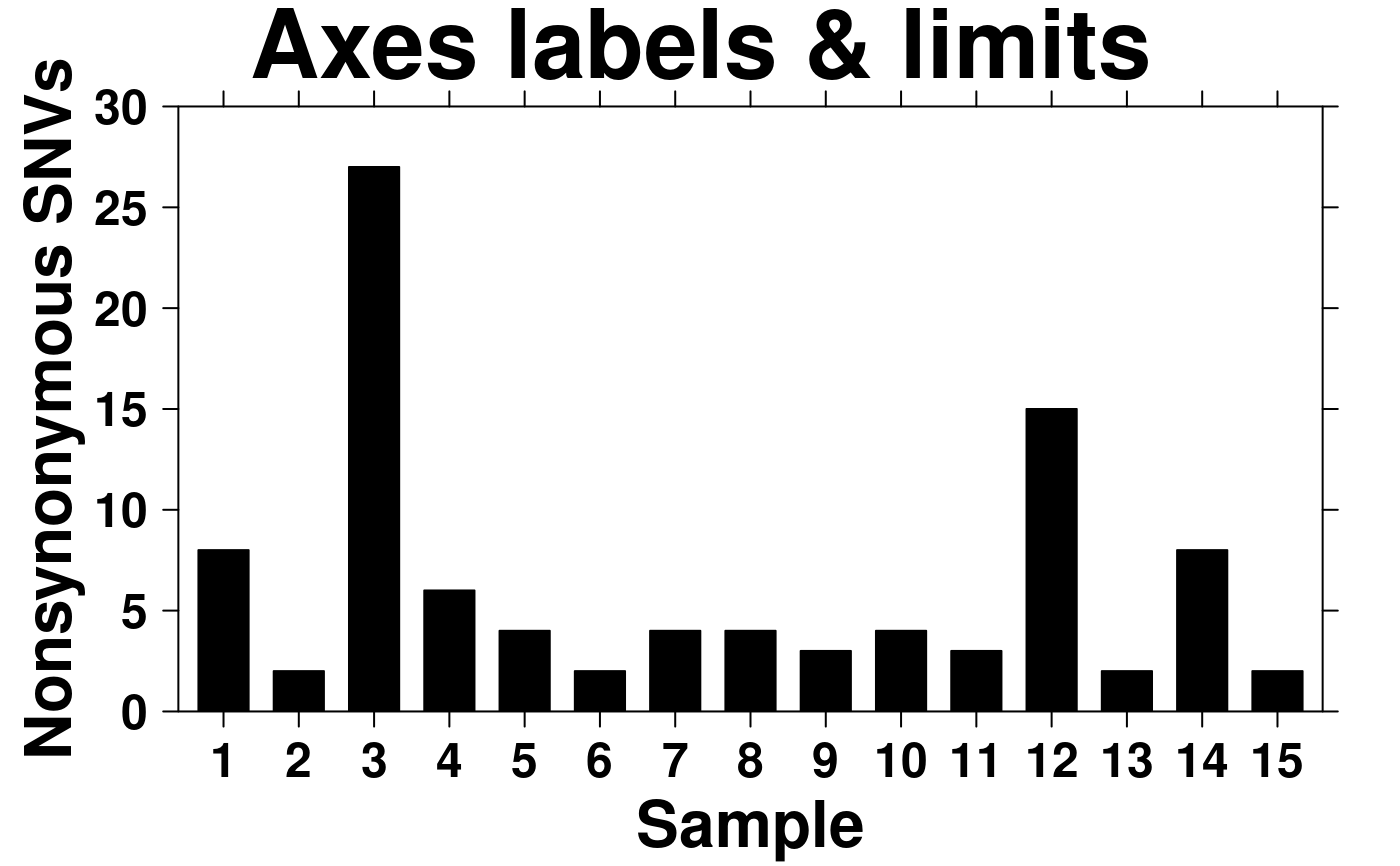 # Font size and font face
create.barplot(
# filename = tempfile(pattern = 'Barplot_Font_Changes', fileext = '.tiff'),
formula = values ~ samples,
data = barplot.data[barplot.data$mutation == 'nonsynonymous',],
main = 'Font changes',
xlab.lab = 'Samples',
ylab.lab = 'Nonsynonymous SNVs',
ylimits = c(0,30),
yat = seq(0,30,5),
# Changing font sizes
xaxis.cex = 1,
yaxis.cex = 1,
xlab.cex = 1.5,
ylab.cex = 1.5,
# Changing font type
xaxis.fontface = 1,
yaxis.fontface = 1,
description = 'Barplot created by BoutrosLab.plotting.general',
resolution = 100
);
# Font size and font face
create.barplot(
# filename = tempfile(pattern = 'Barplot_Font_Changes', fileext = '.tiff'),
formula = values ~ samples,
data = barplot.data[barplot.data$mutation == 'nonsynonymous',],
main = 'Font changes',
xlab.lab = 'Samples',
ylab.lab = 'Nonsynonymous SNVs',
ylimits = c(0,30),
yat = seq(0,30,5),
# Changing font sizes
xaxis.cex = 1,
yaxis.cex = 1,
xlab.cex = 1.5,
ylab.cex = 1.5,
# Changing font type
xaxis.fontface = 1,
yaxis.fontface = 1,
description = 'Barplot created by BoutrosLab.plotting.general',
resolution = 100
);
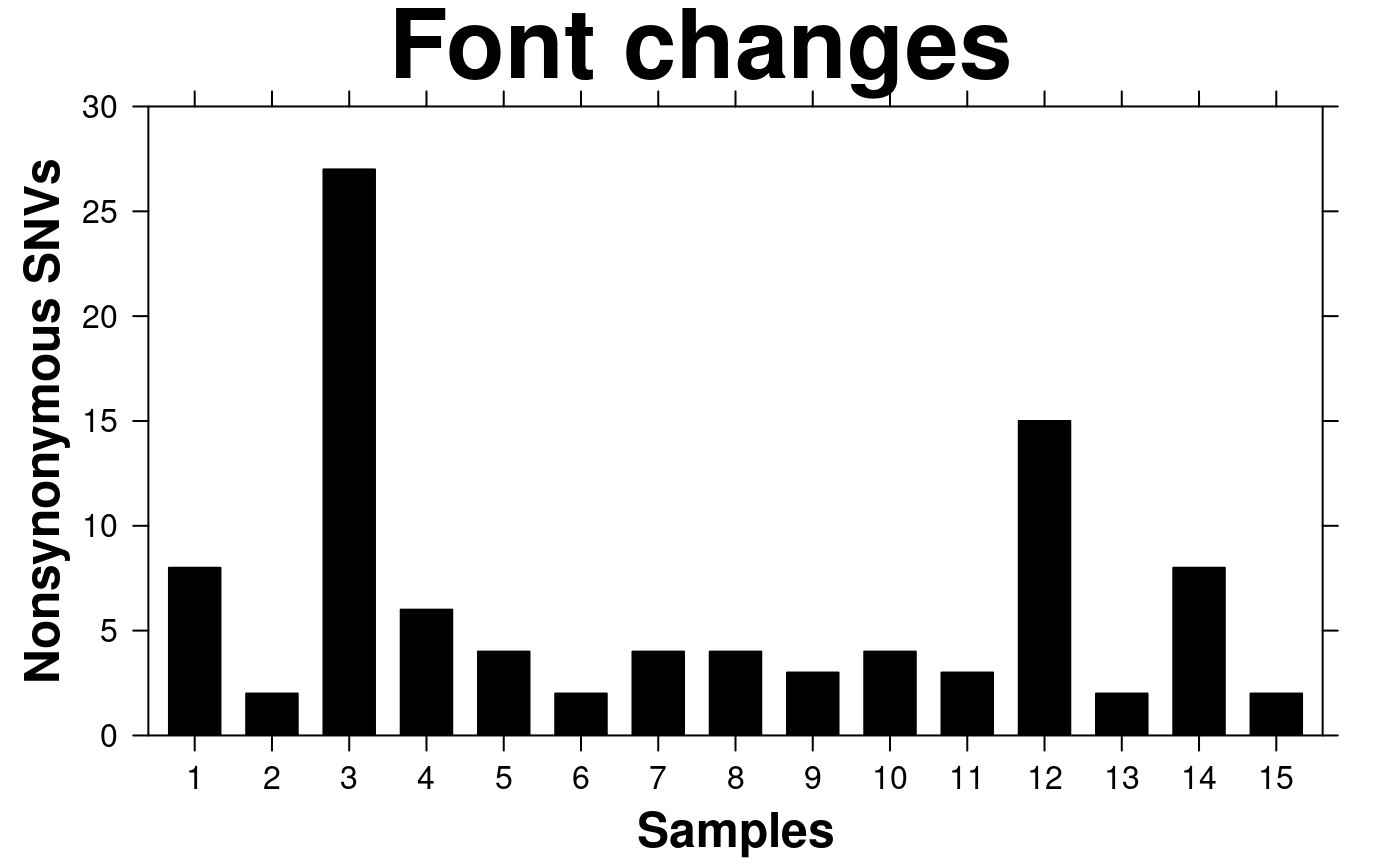 # \donttest{
# Sorting data
create.barplot(
# filename = tempfile(pattern = 'Barplot_Sorted', fileext = '.tiff'),
formula = values ~ samples,
data = barplot.data[barplot.data$mutation == 'nonsynonymous',],
main = 'Sorted bars',
xlab.lab = 'Samples',
ylab.lab = 'Nonsynonymous SNVs',
ylimits = c(0,30),
yat = seq(0,30,5),
xaxis.cex = 1,
yaxis.cex = 1,
xlab.cex = 1.5,
ylab.cex = 1.5,
xaxis.fontface = 1,
yaxis.fontface = 1,
# Order bars either by 'increasing' or 'decreasing'
sample.order = 'decreasing',
description = 'Barplot created by BoutrosLab.plotting.general',
resolution = 100
);
# \donttest{
# Sorting data
create.barplot(
# filename = tempfile(pattern = 'Barplot_Sorted', fileext = '.tiff'),
formula = values ~ samples,
data = barplot.data[barplot.data$mutation == 'nonsynonymous',],
main = 'Sorted bars',
xlab.lab = 'Samples',
ylab.lab = 'Nonsynonymous SNVs',
ylimits = c(0,30),
yat = seq(0,30,5),
xaxis.cex = 1,
yaxis.cex = 1,
xlab.cex = 1.5,
ylab.cex = 1.5,
xaxis.fontface = 1,
yaxis.fontface = 1,
# Order bars either by 'increasing' or 'decreasing'
sample.order = 'decreasing',
description = 'Barplot created by BoutrosLab.plotting.general',
resolution = 100
);
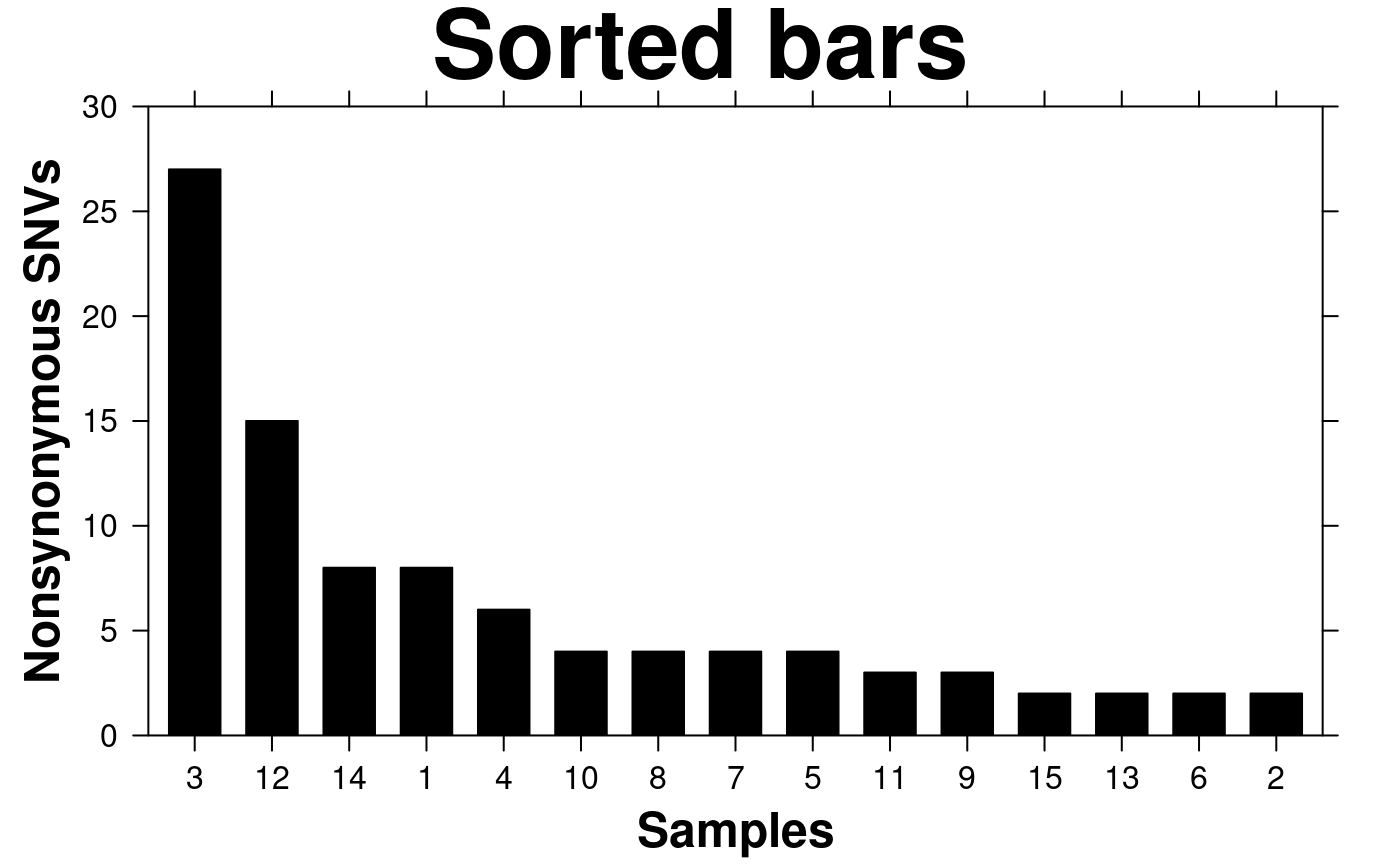 # Sorting data with horizontal barplot
create.barplot(
formula = samples ~ values,
data = barplot.data[barplot.data$mutation == 'nonsynonymous',],
main = 'Sorted bars',
xlab.lab = 'Samples',
ylab.lab = 'Nonsynonymous SNVs',
xlimits = c(0,30),
xat = seq(0,30,5),
xaxis.cex = 1,
yaxis.cex = 1,
xlab.cex = 1.5,
ylab.cex = 1.5,
xaxis.fontface = 1,
yaxis.fontface = 1,
# Order bars either by 'increasing' or 'decreasing'
sample.order = 'decreasing',
plot.horizontal = TRUE,
resolution = 100
)
# Sorting data with horizontal barplot
create.barplot(
formula = samples ~ values,
data = barplot.data[barplot.data$mutation == 'nonsynonymous',],
main = 'Sorted bars',
xlab.lab = 'Samples',
ylab.lab = 'Nonsynonymous SNVs',
xlimits = c(0,30),
xat = seq(0,30,5),
xaxis.cex = 1,
yaxis.cex = 1,
xlab.cex = 1.5,
ylab.cex = 1.5,
xaxis.fontface = 1,
yaxis.fontface = 1,
# Order bars either by 'increasing' or 'decreasing'
sample.order = 'decreasing',
plot.horizontal = TRUE,
resolution = 100
)
 # Log-Scaled Axis
log.data <- data.frame(
x = 10 ** sample(1:15, 5),
y = LETTERS[1:5]
);
create.barplot(
formula = x ~ y,
data = log.data,
# Log base 10 scale y-axis
yat = 'auto.log',
main = 'Log Scaled',
description = 'Barplot created by BoutrosLab.plotting.general',
resolution = 100
);
# Log-Scaled Axis
log.data <- data.frame(
x = 10 ** sample(1:15, 5),
y = LETTERS[1:5]
);
create.barplot(
formula = x ~ y,
data = log.data,
# Log base 10 scale y-axis
yat = 'auto.log',
main = 'Log Scaled',
description = 'Barplot created by BoutrosLab.plotting.general',
resolution = 100
);
 # Colour changes
sex.colours <- replace(as.vector(barplot.data$sex), which(barplot.data$sex == 'male'),'dodgerblue');
sex.colours <- replace(sex.colours, which(barplot.data$sex == 'female'), 'pink');
create.barplot(
# filename = tempfile(pattern = 'Barplot_Colour_Changes', fileext = '.tiff'),
formula = values ~ samples,
data = barplot.data[barplot.data$mutation == 'nonsynonymous',],
main = 'Colour changes',
xlab.lab = 'Samples',
ylab.lab = 'Nonsynonymous SNVs',
ylimits = c(0,30),
yat = seq(0,30,5),
xaxis.cex = 1,
yaxis.cex = 1,
xlab.cex = 1.5,
ylab.cex = 1.5,
xaxis.fontface = 1,
yaxis.fontface = 1,
# Colour bars based on sex
col = sex.colours,
description = 'Barplot created by BoutrosLab.plotting.general',
resolution = 100
);
# Colour changes
sex.colours <- replace(as.vector(barplot.data$sex), which(barplot.data$sex == 'male'),'dodgerblue');
sex.colours <- replace(sex.colours, which(barplot.data$sex == 'female'), 'pink');
create.barplot(
# filename = tempfile(pattern = 'Barplot_Colour_Changes', fileext = '.tiff'),
formula = values ~ samples,
data = barplot.data[barplot.data$mutation == 'nonsynonymous',],
main = 'Colour changes',
xlab.lab = 'Samples',
ylab.lab = 'Nonsynonymous SNVs',
ylimits = c(0,30),
yat = seq(0,30,5),
xaxis.cex = 1,
yaxis.cex = 1,
xlab.cex = 1.5,
ylab.cex = 1.5,
xaxis.fontface = 1,
yaxis.fontface = 1,
# Colour bars based on sex
col = sex.colours,
description = 'Barplot created by BoutrosLab.plotting.general',
resolution = 100
);
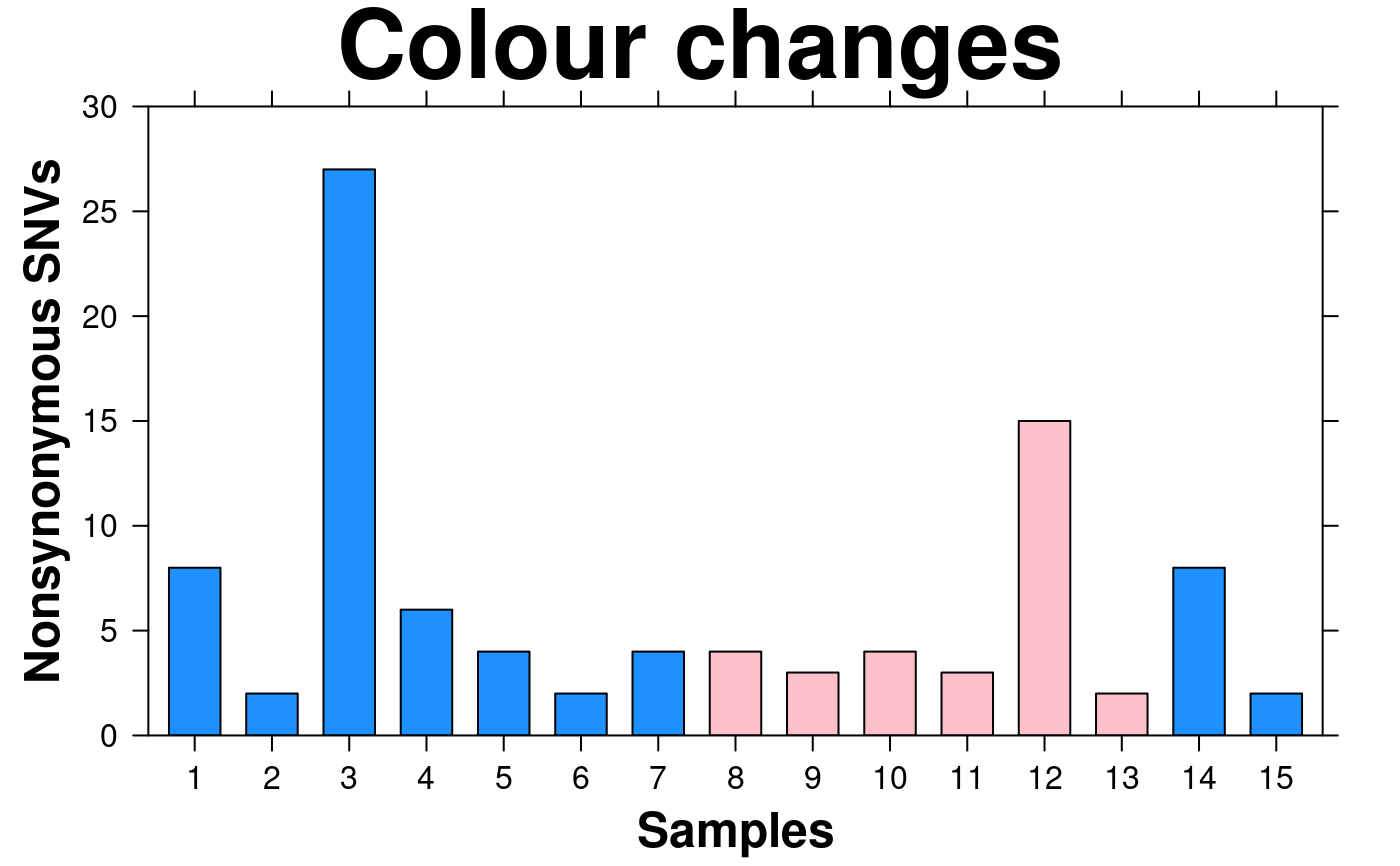 # Legend
create.barplot(
# filename = tempfile(pattern = 'Barplot_Legend', fileext = '.tiff'),
formula = values ~ samples,
data = barplot.data[barplot.data$mutation == 'nonsynonymous',],
main = 'Legend',
xlab.lab = 'Samples',
ylab.lab = 'Nonsynonymous SNVs',
ylimits = c(0,30),
yat = seq(0,30,5),
xaxis.cex = 1,
yaxis.cex = 1,
xlab.cex = 1.5,
ylab.cex = 1.5,
xaxis.fontface = 1,
yaxis.fontface = 1,
col = sex.colours,
# Adding legend to explain bar colour-coding
legend = list(
inside = list(
fun = draw.key,
args = list(
key = list(
points = list(
col = 'black',
pch = 22,
cex = 3,
fill = c('dodgerblue', 'pink')
),
text = list(
lab = c('Male','Female')
),
padding.text = 5,
cex = 1
)
),
# Positioning legend on plot
x = 0.75,
y = 0.95
)
),
description = 'Barplot created by BoutrosLab.plotting.general',
resolution = 100
);
# Legend
create.barplot(
# filename = tempfile(pattern = 'Barplot_Legend', fileext = '.tiff'),
formula = values ~ samples,
data = barplot.data[barplot.data$mutation == 'nonsynonymous',],
main = 'Legend',
xlab.lab = 'Samples',
ylab.lab = 'Nonsynonymous SNVs',
ylimits = c(0,30),
yat = seq(0,30,5),
xaxis.cex = 1,
yaxis.cex = 1,
xlab.cex = 1.5,
ylab.cex = 1.5,
xaxis.fontface = 1,
yaxis.fontface = 1,
col = sex.colours,
# Adding legend to explain bar colour-coding
legend = list(
inside = list(
fun = draw.key,
args = list(
key = list(
points = list(
col = 'black',
pch = 22,
cex = 3,
fill = c('dodgerblue', 'pink')
),
text = list(
lab = c('Male','Female')
),
padding.text = 5,
cex = 1
)
),
# Positioning legend on plot
x = 0.75,
y = 0.95
)
),
description = 'Barplot created by BoutrosLab.plotting.general',
resolution = 100
);
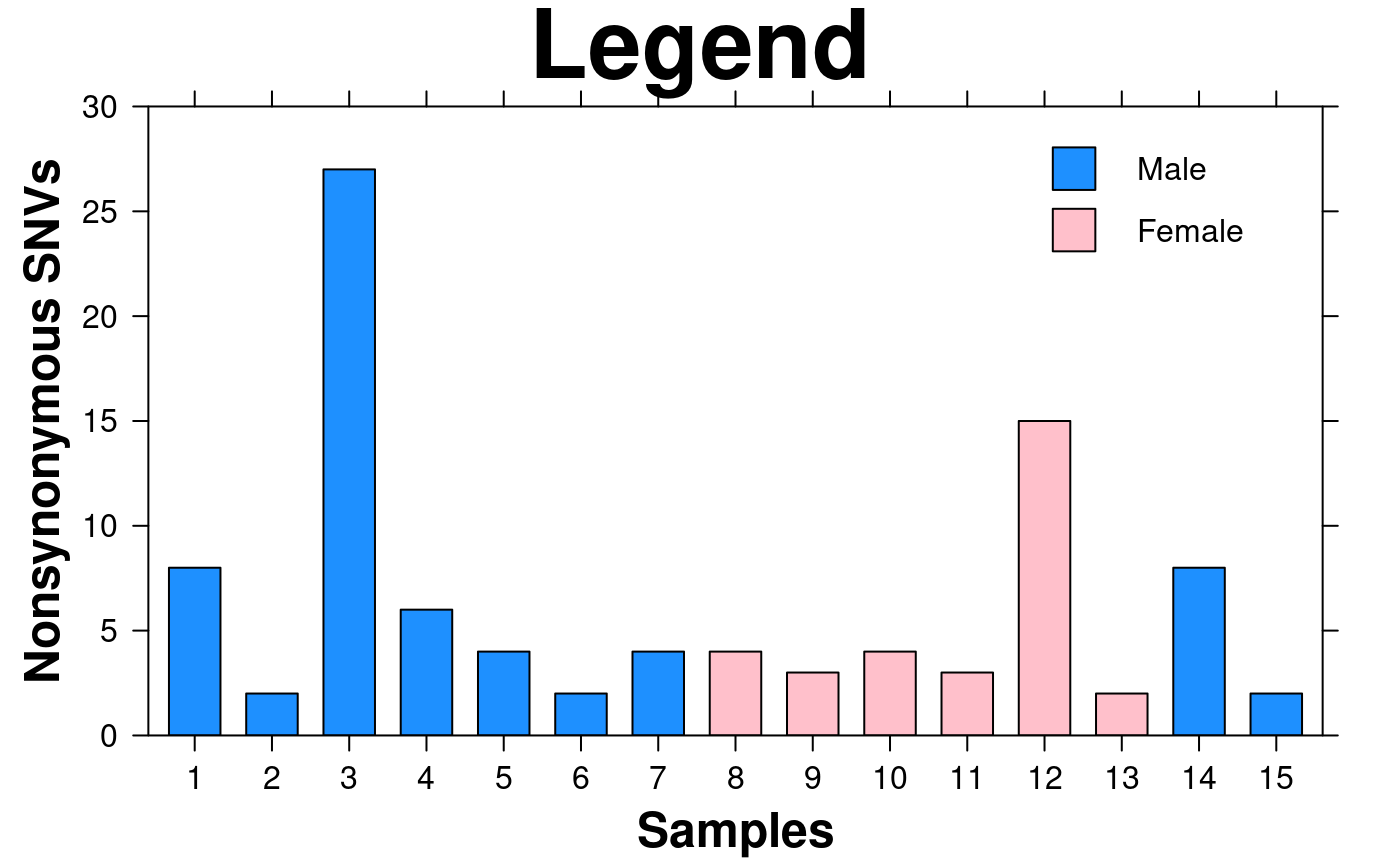 # Grouped barplot
create.barplot(
# filename = tempfile(pattern = 'Barplot_Grouped', fileext = '.tiff'),
formula = values ~ samples,
data = barplot.data,
main = 'Grouped bar chart',
xlab.lab = 'Samples',
ylab.lab = 'Mutations',
ylimits = c(0,30),
yat = seq(0,30,5),
xaxis.cex = 1,
yaxis.cex = 1,
xlab.cex = 1.5,
ylab.cex = 1.5,
xaxis.fontface = 1,
yaxis.fontface = 1,
# Setting groups
groups = mutation,
col = default.colours(12, is.greyscale = FALSE)[11:12],
legend = list(
inside = list(
fun = draw.key,
args = list(
key = list(
points = list(
col = 'black',
pch = 22,
cex = 2,
fill = default.colours(12, is.greyscale = FALSE)[11:12]
),
text = list(
lab = c('Nonsynonymous SNV','Other SNV')
),
padding.text = 3,
cex = 1
)
),
x = 0.55,
y = 0.95
)
),
description = 'Barplot created by BoutrosLab.plotting.general',
resolution = 100
);
# Grouped barplot
create.barplot(
# filename = tempfile(pattern = 'Barplot_Grouped', fileext = '.tiff'),
formula = values ~ samples,
data = barplot.data,
main = 'Grouped bar chart',
xlab.lab = 'Samples',
ylab.lab = 'Mutations',
ylimits = c(0,30),
yat = seq(0,30,5),
xaxis.cex = 1,
yaxis.cex = 1,
xlab.cex = 1.5,
ylab.cex = 1.5,
xaxis.fontface = 1,
yaxis.fontface = 1,
# Setting groups
groups = mutation,
col = default.colours(12, is.greyscale = FALSE)[11:12],
legend = list(
inside = list(
fun = draw.key,
args = list(
key = list(
points = list(
col = 'black',
pch = 22,
cex = 2,
fill = default.colours(12, is.greyscale = FALSE)[11:12]
),
text = list(
lab = c('Nonsynonymous SNV','Other SNV')
),
padding.text = 3,
cex = 1
)
),
x = 0.55,
y = 0.95
)
),
description = 'Barplot created by BoutrosLab.plotting.general',
resolution = 100
);
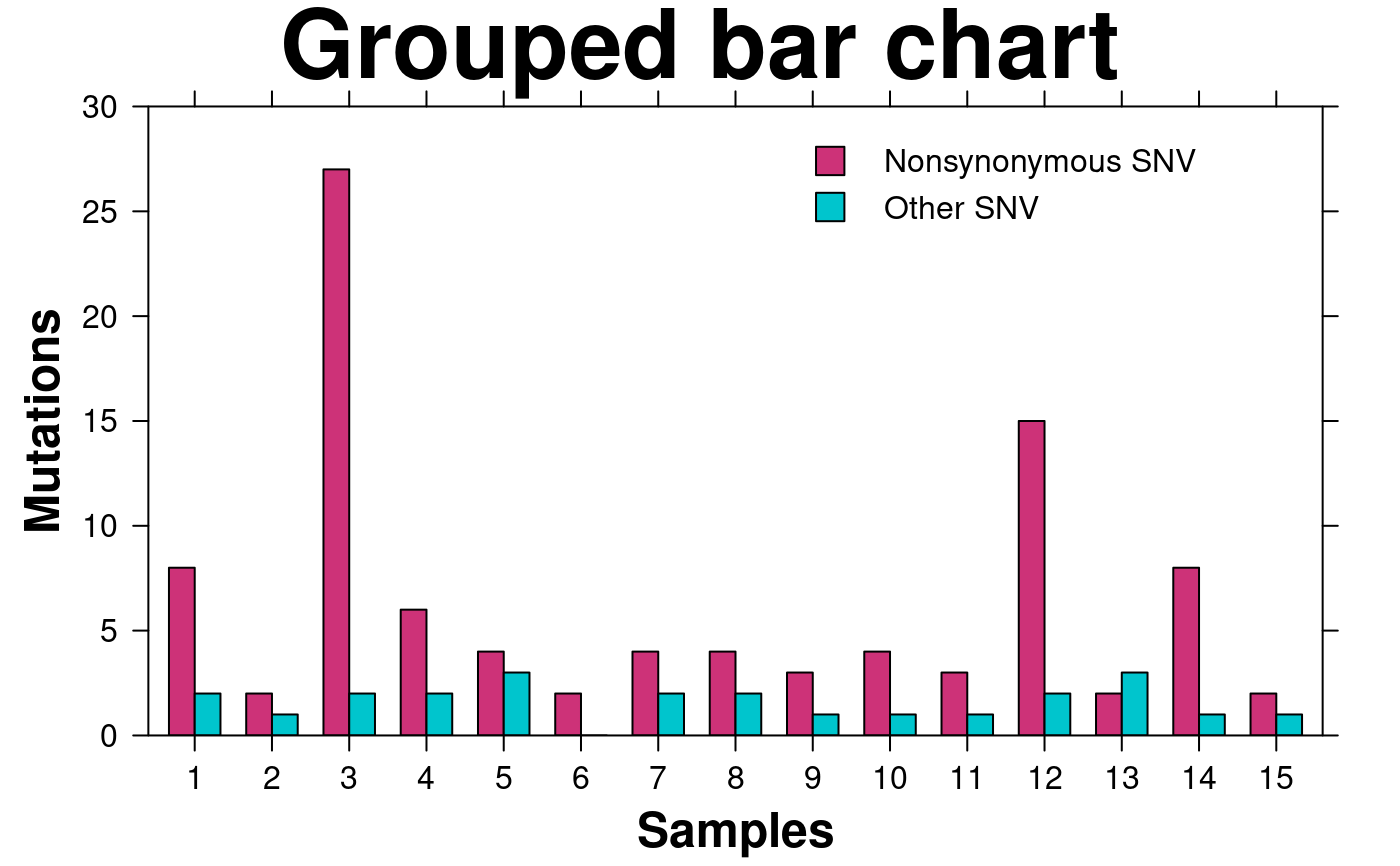 # Grouped labels
create.barplot(
# filename = tempfile(pattern = 'Barplot_Grouped_Labels', fileext = '.tiff'),
formula = values ~ samples,
data = barplot.data,
main = 'Grouped labels',
xlab.lab = 'Samples',
ylab.lab = 'Mutations',
ylimits = c(0,30),
yat = seq(0,30,5),
xaxis.cex = 1,
yaxis.cex = 1,
xlab.cex = 1.5,
ylab.cex = 1.5,
xaxis.fontface = 1,
yaxis.fontface = 1,
# Setting groups
groups = mutation,
col = default.colours(12, is.greyscale = FALSE)[11:12],
# Grouped labels
xaxis.lab = rep(c('nonsynonymous', 'other'), 15),
xaxis.rot = 90,
group.labels = TRUE,
description = 'Barplot created by BoutrosLab.plotting.general',
resolution = 200
);
# Grouped labels
create.barplot(
# filename = tempfile(pattern = 'Barplot_Grouped_Labels', fileext = '.tiff'),
formula = values ~ samples,
data = barplot.data,
main = 'Grouped labels',
xlab.lab = 'Samples',
ylab.lab = 'Mutations',
ylimits = c(0,30),
yat = seq(0,30,5),
xaxis.cex = 1,
yaxis.cex = 1,
xlab.cex = 1.5,
ylab.cex = 1.5,
xaxis.fontface = 1,
yaxis.fontface = 1,
# Setting groups
groups = mutation,
col = default.colours(12, is.greyscale = FALSE)[11:12],
# Grouped labels
xaxis.lab = rep(c('nonsynonymous', 'other'), 15),
xaxis.rot = 90,
group.labels = TRUE,
description = 'Barplot created by BoutrosLab.plotting.general',
resolution = 200
);
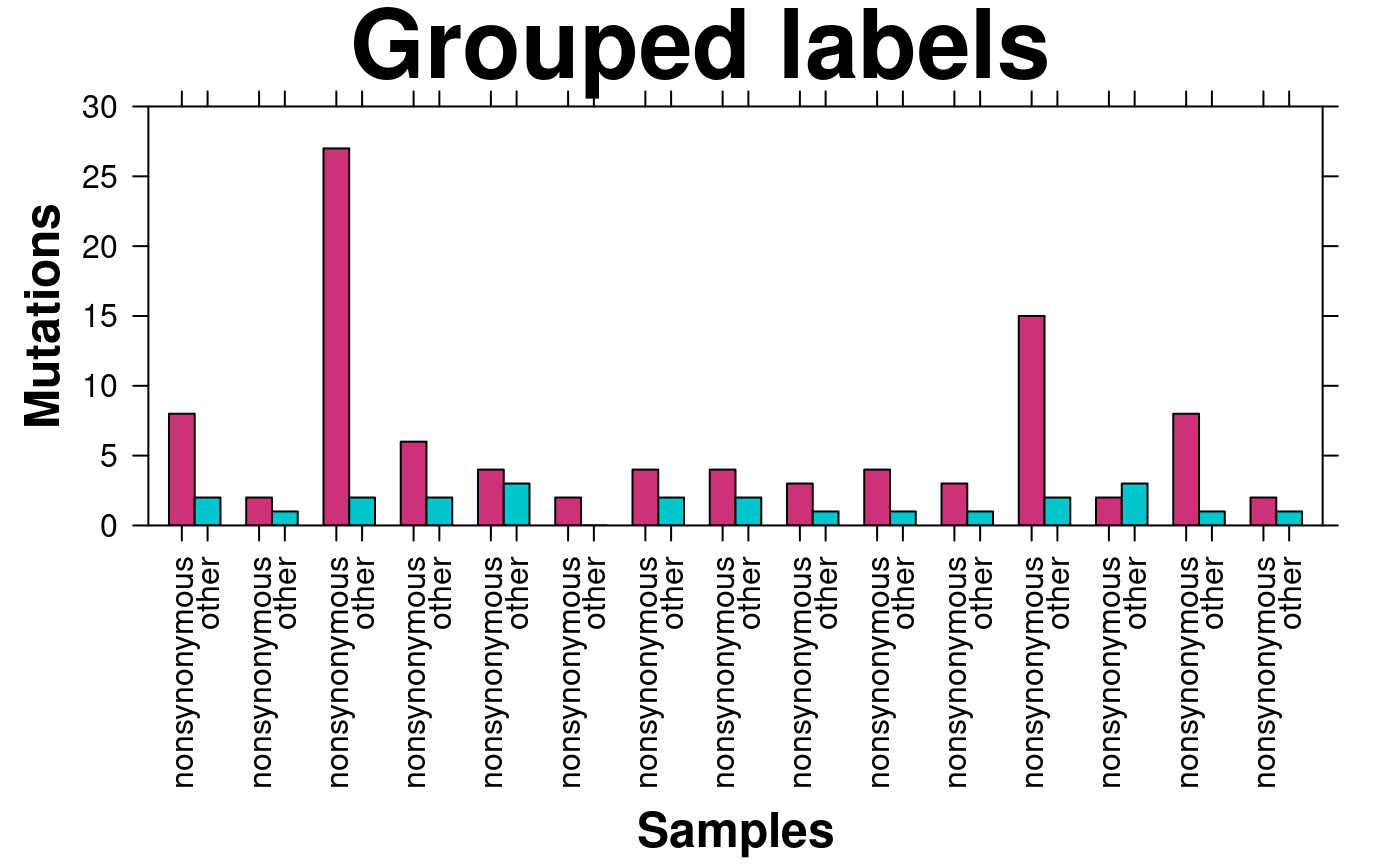 # Stacked barplot
create.barplot(
# filename = tempfile(pattern = 'Barplot_Stacked', fileext = '.tiff'),
formula = values ~ samples,
data = barplot.data,
main = 'Stacked bar chart',
xlab.lab = 'Samples',
ylab.lab = 'Mutations',
ylimits = c(0,30),
yat = seq(0,30,5),
xaxis.cex = 1,
yaxis.cex = 1,
xlab.cex = 1.5,
ylab.cex = 1.5,
xaxis.fontface = 1,
yaxis.fontface = 1,
groups = mutation,
col = default.colours(12, is.greyscale = FALSE)[11:12],
legend = list(
inside = list(
fun = draw.key,
args = list(
key = list(
points = list(
col = 'black',
pch = 22,
cex = 2,
# reverse order to match stacked bar order
fill = rev(default.colours(12, is.greyscale = FALSE)[11:12])
),
text = list(
# reverse order to match stacked bar order
lab = rev(c('Nonsynonymous SNV','Other SNV'))
),
padding.text = 3,
cex = 1
)
),
x = 0.55,
y = 0.95
)
),
# Changing the plot from a grouped plot to a stacked plot
stack = TRUE,
description = 'Barplot created by BoutrosLab.plotting.general',
resolution = 200
);
# Stacked barplot
create.barplot(
# filename = tempfile(pattern = 'Barplot_Stacked', fileext = '.tiff'),
formula = values ~ samples,
data = barplot.data,
main = 'Stacked bar chart',
xlab.lab = 'Samples',
ylab.lab = 'Mutations',
ylimits = c(0,30),
yat = seq(0,30,5),
xaxis.cex = 1,
yaxis.cex = 1,
xlab.cex = 1.5,
ylab.cex = 1.5,
xaxis.fontface = 1,
yaxis.fontface = 1,
groups = mutation,
col = default.colours(12, is.greyscale = FALSE)[11:12],
legend = list(
inside = list(
fun = draw.key,
args = list(
key = list(
points = list(
col = 'black',
pch = 22,
cex = 2,
# reverse order to match stacked bar order
fill = rev(default.colours(12, is.greyscale = FALSE)[11:12])
),
text = list(
# reverse order to match stacked bar order
lab = rev(c('Nonsynonymous SNV','Other SNV'))
),
padding.text = 3,
cex = 1
)
),
x = 0.55,
y = 0.95
)
),
# Changing the plot from a grouped plot to a stacked plot
stack = TRUE,
description = 'Barplot created by BoutrosLab.plotting.general',
resolution = 200
);
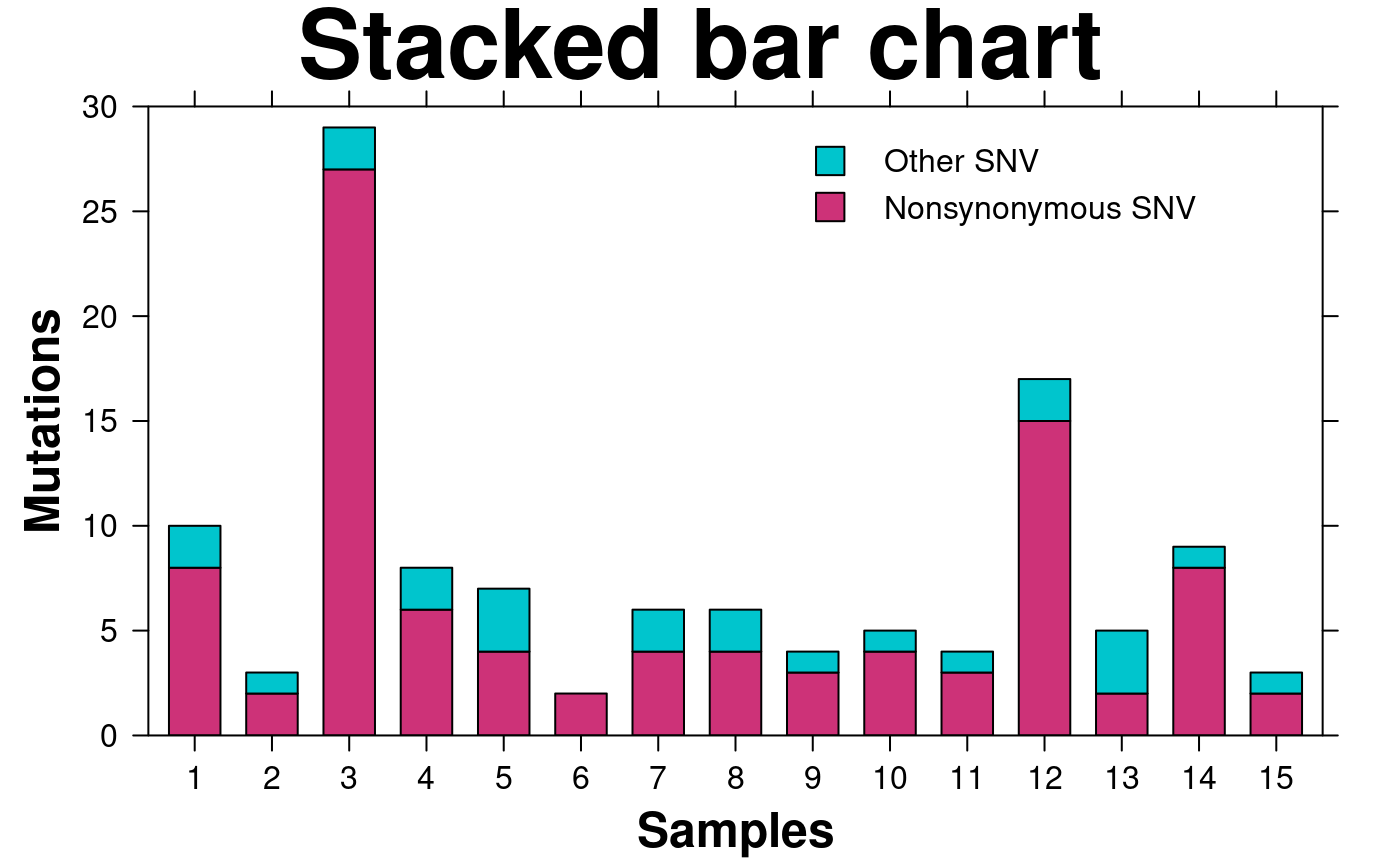 # Panel organization
create.barplot(
# filename = tempfile(pattern = 'Barplot_Panel_Layout_numeric_conditioning', fileext = '.tiff'),
# Setting the panel layout
formula = values ~ samples | type,
data = barplot.data,
main = 'Panel layout',
xlab.lab = 'Samples',
ylab.lab = 'Mutations',
ylimits = c(0,30),
yat = seq(0,30,5),
xaxis.cex = 1,
yaxis.cex = 1,
xlab.cex = 1.5,
ylab.cex = 1.5,
xaxis.fontface = 1,
yaxis.fontface = 1,
description = 'Barplot created by BoutrosLab.plotting.general',
resolution = 200
);
#> Warning: Numeric values detected for conditional variable. If text labels are desired, please convert conditional variable to character.
# Panel organization
create.barplot(
# filename = tempfile(pattern = 'Barplot_Panel_Layout_numeric_conditioning', fileext = '.tiff'),
# Setting the panel layout
formula = values ~ samples | type,
data = barplot.data,
main = 'Panel layout',
xlab.lab = 'Samples',
ylab.lab = 'Mutations',
ylimits = c(0,30),
yat = seq(0,30,5),
xaxis.cex = 1,
yaxis.cex = 1,
xlab.cex = 1.5,
ylab.cex = 1.5,
xaxis.fontface = 1,
yaxis.fontface = 1,
description = 'Barplot created by BoutrosLab.plotting.general',
resolution = 200
);
#> Warning: Numeric values detected for conditional variable. If text labels are desired, please convert conditional variable to character.
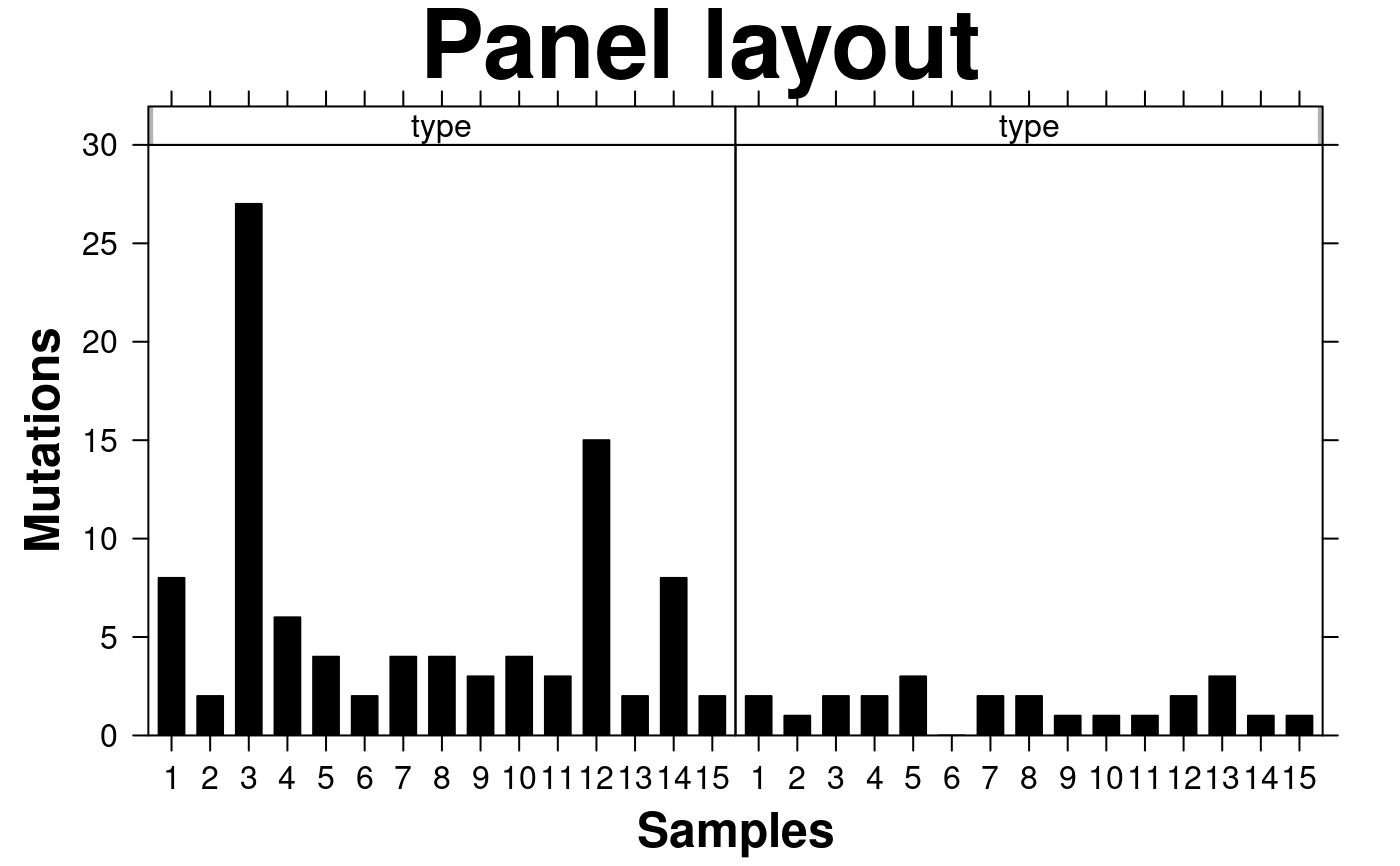 create.barplot(
# Setting the panel layout
formula = values ~ samples | mutation,
data = barplot.data,
main = 'Panel layout',
xlab.lab = 'Samples',
ylab.lab = 'Mutations',
ylimits = c(0,30),
yat = seq(0,30,5),
xaxis.cex = 1,
yaxis.cex = 1,
xlab.cex = 1.5,
ylab.cex = 1.5,
xaxis.fontface = 1,
yaxis.fontface = 1,
description = 'Barplot created by BoutrosLab.plotting.general',
resolution = 200
);
create.barplot(
# Setting the panel layout
formula = values ~ samples | mutation,
data = barplot.data,
main = 'Panel layout',
xlab.lab = 'Samples',
ylab.lab = 'Mutations',
ylimits = c(0,30),
yat = seq(0,30,5),
xaxis.cex = 1,
yaxis.cex = 1,
xlab.cex = 1.5,
ylab.cex = 1.5,
xaxis.fontface = 1,
yaxis.fontface = 1,
description = 'Barplot created by BoutrosLab.plotting.general',
resolution = 200
);
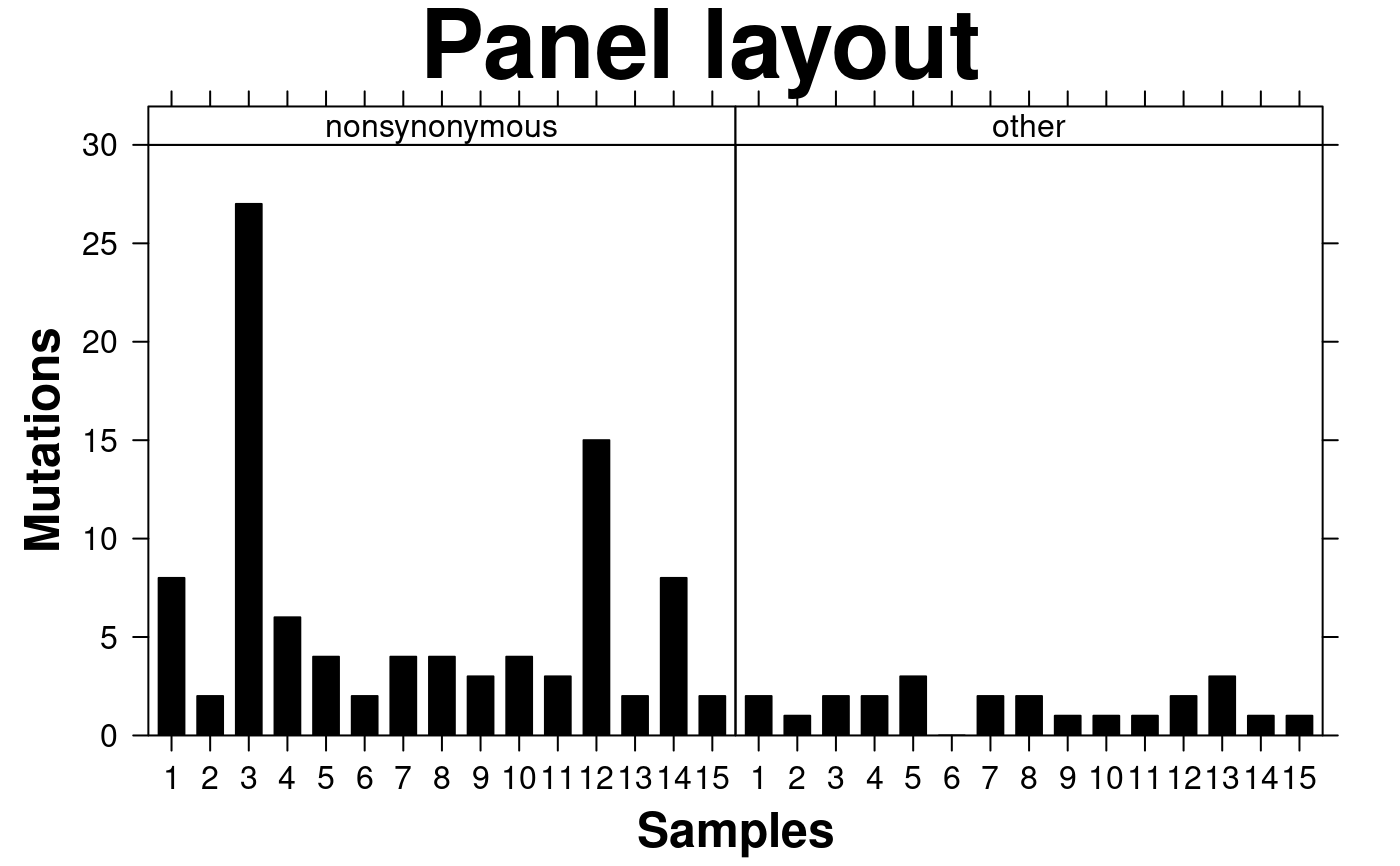 # Panel organization 2
create.barplot(
# filename = tempfile(pattern = 'Barplot_Panel_Layout_2', fileext = '.tiff'),
formula = values ~ samples | mutation,
data = barplot.data,
main = 'Panel layout',
xlab.lab = 'Samples',
ylab.lab = 'Mutations',
ylimits = c(0,30),
yat = seq(0,30,5),
xaxis.cex = 1,
yaxis.cex = 1,
xlab.cex = 1.5,
ylab.cex = 1.5,
xaxis.fontface = 1,
yaxis.fontface = 1,
# Adjusting the panel layout
layout = c(1,2),
y.spacing = 1,
description = 'Barplot created by BoutrosLab.plotting.general',
resolution = 200
);
# Panel organization 2
create.barplot(
# filename = tempfile(pattern = 'Barplot_Panel_Layout_2', fileext = '.tiff'),
formula = values ~ samples | mutation,
data = barplot.data,
main = 'Panel layout',
xlab.lab = 'Samples',
ylab.lab = 'Mutations',
ylimits = c(0,30),
yat = seq(0,30,5),
xaxis.cex = 1,
yaxis.cex = 1,
xlab.cex = 1.5,
ylab.cex = 1.5,
xaxis.fontface = 1,
yaxis.fontface = 1,
# Adjusting the panel layout
layout = c(1,2),
y.spacing = 1,
description = 'Barplot created by BoutrosLab.plotting.general',
resolution = 200
);
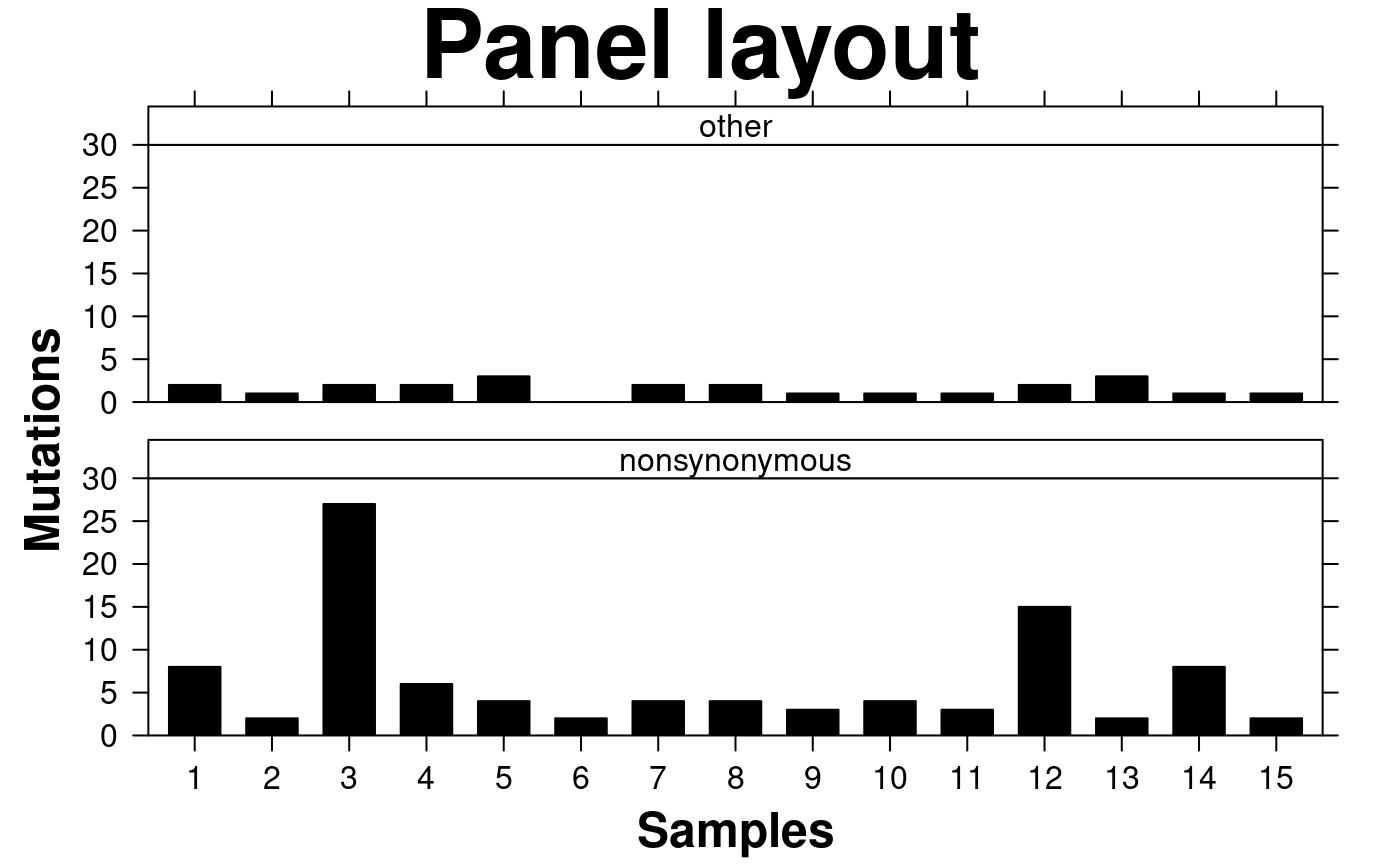 # Covariates
# Note: Covariates can also be created using the create.multiplot function
# set covariate colour schemes
covariate.colours.sex <- as.character(barplot.data$sex);
covariate.colours.sex[covariate.colours.sex == 'male'] <- 'dodgerblue';
covariate.colours.sex[covariate.colours.sex == 'female'] <- 'pink';
covariate.colours.stage <- as.character(barplot.data$stage);
covariate.colours.stage[covariate.colours.stage == 'I'] <- 'plum1';
covariate.colours.stage[covariate.colours.stage == 'II'] <- 'orchid1';
covariate.colours.stage[covariate.colours.stage == 'III'] <- 'orchid3';
covariate.colours.stage[covariate.colours.stage == 'IV'] <- 'orchid4';
covariate.colours.msi <- as.character(barplot.data$msi);
covariate.colours.msi[covariate.colours.msi == 'MSS'] <- 'chartreuse4';
covariate.colours.msi[covariate.colours.msi == 'MSI-High'] <- 'chartreuse2';
# create object to draw covariates
covariates.object <- list(
rect = list(
col = 'white',
fill = covariate.colours.sex,
lwd = 1.5
),
rect = list(
col = 'white',
fill = covariate.colours.stage,
lwd = 1.5
),
rect = list(
col = 'white',
fill = covariate.colours.msi,
lwd = 1.5
)
);
# see BoutrosLab.plotting.general::covariates.grob() for more information
covariate.object.grob <- covariates.grob(
covariates = covariates.object,
ord = c(1:15),
side = 'top',
size = 0.8
);
# Create legend to explain covariates
covariates.legends <- list(
legend = list(
colours = c('dodgerblue','pink'),
labels = c('male','female'),
title = 'Sex',
border = 'white'
),
legend = list(
colours = c('plum1', 'orchid1', 'orchid3', 'orchid4'),
labels = c('I','II','III','IV'),
title = 'Stage',
border = 'white'
),
legend = list(
colours = c('chartreuse4','chartreuse2'),
labels = c('MSS','MSI-High'),
title = 'MSI',
border = 'white'
)
);
# see BoutrosLab.plotting.general::legend.grob() for more information
covariate.legend.grob <- legend.grob(
legends = covariates.legends,
title.just = 'left'
);
create.barplot(
# filename = tempfile(pattern = 'Barplot_Covariates', fileext = '.tiff'),
formula = values ~ samples,
data = barplot.data[barplot.data$mutation == 'nonsynonymous',],
main = 'Covariates',
ylab.lab = 'Mutations',
ylimits = c(0,30),
yat = seq(0,30,5),
yaxis.cex = 1,
xlab.cex = 1.5,
ylab.cex = 1.5,
yaxis.fontface = 1,
# removing x-axis formatting to give space to covariates
xaxis.tck = 0,
xaxis.lab = rep('',15),
xaxis.cex = 0,
# covariates
legend = list(
bottom = list(fun = covariate.object.grob),
right = list(fun = covariate.legend.grob)
),
key = list(
x = 1,
y = -0.028,
text = list(
lab = c('Sex','Stage','MSI')
),
padding.text = 1
),
bottom.padding = 4,
description = 'Barplot created by BoutrosLab.plotting.general',
resolution = 200
);
# Covariates
# Note: Covariates can also be created using the create.multiplot function
# set covariate colour schemes
covariate.colours.sex <- as.character(barplot.data$sex);
covariate.colours.sex[covariate.colours.sex == 'male'] <- 'dodgerblue';
covariate.colours.sex[covariate.colours.sex == 'female'] <- 'pink';
covariate.colours.stage <- as.character(barplot.data$stage);
covariate.colours.stage[covariate.colours.stage == 'I'] <- 'plum1';
covariate.colours.stage[covariate.colours.stage == 'II'] <- 'orchid1';
covariate.colours.stage[covariate.colours.stage == 'III'] <- 'orchid3';
covariate.colours.stage[covariate.colours.stage == 'IV'] <- 'orchid4';
covariate.colours.msi <- as.character(barplot.data$msi);
covariate.colours.msi[covariate.colours.msi == 'MSS'] <- 'chartreuse4';
covariate.colours.msi[covariate.colours.msi == 'MSI-High'] <- 'chartreuse2';
# create object to draw covariates
covariates.object <- list(
rect = list(
col = 'white',
fill = covariate.colours.sex,
lwd = 1.5
),
rect = list(
col = 'white',
fill = covariate.colours.stage,
lwd = 1.5
),
rect = list(
col = 'white',
fill = covariate.colours.msi,
lwd = 1.5
)
);
# see BoutrosLab.plotting.general::covariates.grob() for more information
covariate.object.grob <- covariates.grob(
covariates = covariates.object,
ord = c(1:15),
side = 'top',
size = 0.8
);
# Create legend to explain covariates
covariates.legends <- list(
legend = list(
colours = c('dodgerblue','pink'),
labels = c('male','female'),
title = 'Sex',
border = 'white'
),
legend = list(
colours = c('plum1', 'orchid1', 'orchid3', 'orchid4'),
labels = c('I','II','III','IV'),
title = 'Stage',
border = 'white'
),
legend = list(
colours = c('chartreuse4','chartreuse2'),
labels = c('MSS','MSI-High'),
title = 'MSI',
border = 'white'
)
);
# see BoutrosLab.plotting.general::legend.grob() for more information
covariate.legend.grob <- legend.grob(
legends = covariates.legends,
title.just = 'left'
);
create.barplot(
# filename = tempfile(pattern = 'Barplot_Covariates', fileext = '.tiff'),
formula = values ~ samples,
data = barplot.data[barplot.data$mutation == 'nonsynonymous',],
main = 'Covariates',
ylab.lab = 'Mutations',
ylimits = c(0,30),
yat = seq(0,30,5),
yaxis.cex = 1,
xlab.cex = 1.5,
ylab.cex = 1.5,
yaxis.fontface = 1,
# removing x-axis formatting to give space to covariates
xaxis.tck = 0,
xaxis.lab = rep('',15),
xaxis.cex = 0,
# covariates
legend = list(
bottom = list(fun = covariate.object.grob),
right = list(fun = covariate.legend.grob)
),
key = list(
x = 1,
y = -0.028,
text = list(
lab = c('Sex','Stage','MSI')
),
padding.text = 1
),
bottom.padding = 4,
description = 'Barplot created by BoutrosLab.plotting.general',
resolution = 200
);
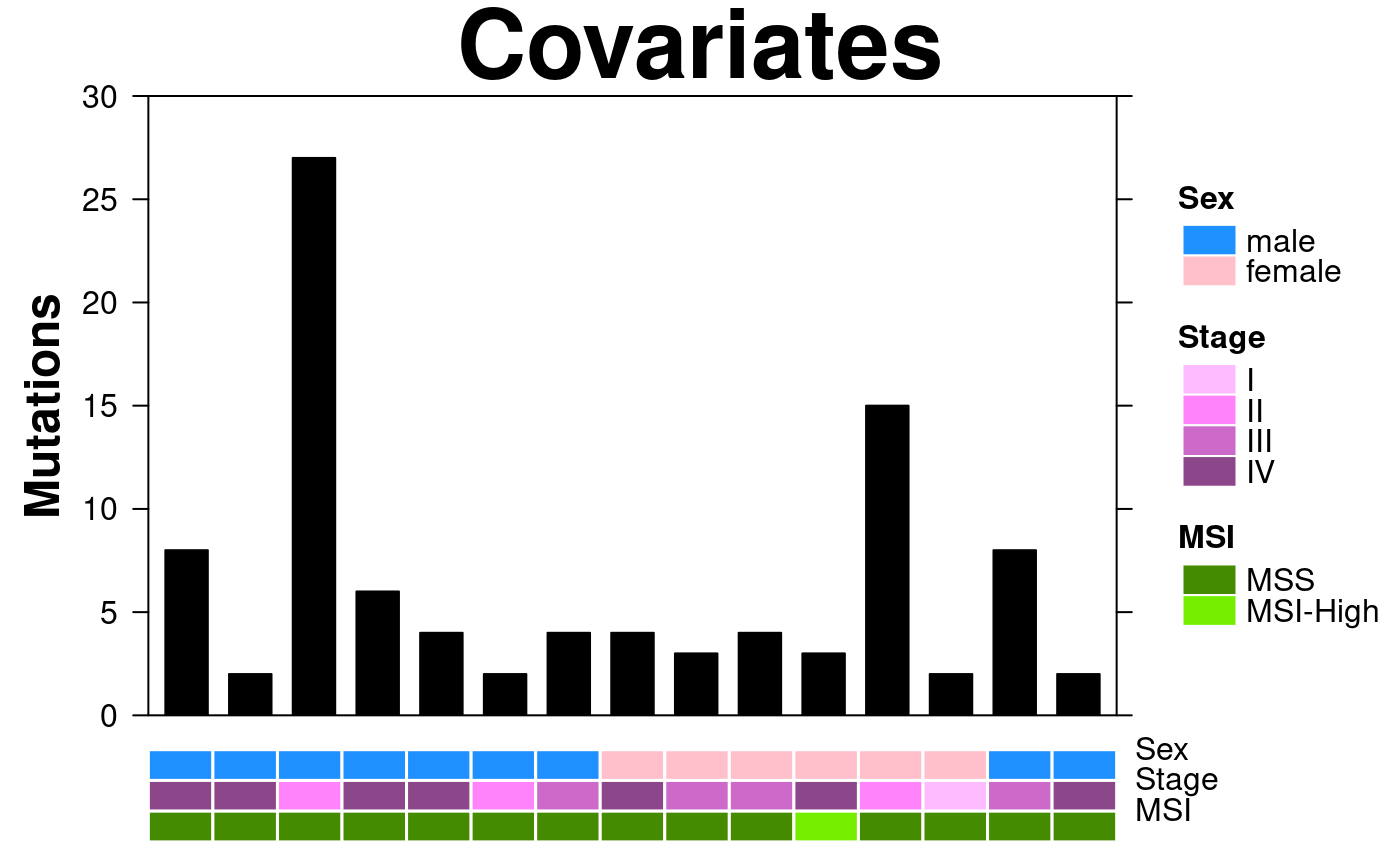 create.barplot(
# filename = tempfile(pattern = 'Barplot_Auto_legend', fileext = '.tiff'),
formula = values ~ samples,
data = barplot.data[barplot.data$mutation == 'nonsynonymous',],
main = 'Covariates',
ylab.lab = 'Mutations',
ylimits = c(0,30),
yat = seq(0,30,5),
yaxis.cex = 1,
xlab.cex = 1.5,
ylab.cex = 1.5,
yaxis.fontface = 1,
# removing x-axis formatting to give space to covariates
xaxis.tck = 0,
xaxis.lab = rep('',15),
xaxis.cex = 0,
# covariates
legend = list(
inside = list(fun = covariate.legend.grob)
),
bottom.padding = 4,
inside.legend.auto = TRUE,
description = 'Barplot created by BoutrosLab.plotting.general',
resolution = 200
);
create.barplot(
# filename = tempfile(pattern = 'Barplot_Auto_legend', fileext = '.tiff'),
formula = values ~ samples,
data = barplot.data[barplot.data$mutation == 'nonsynonymous',],
main = 'Covariates',
ylab.lab = 'Mutations',
ylimits = c(0,30),
yat = seq(0,30,5),
yaxis.cex = 1,
xlab.cex = 1.5,
ylab.cex = 1.5,
yaxis.fontface = 1,
# removing x-axis formatting to give space to covariates
xaxis.tck = 0,
xaxis.lab = rep('',15),
xaxis.cex = 0,
# covariates
legend = list(
inside = list(fun = covariate.legend.grob)
),
bottom.padding = 4,
inside.legend.auto = TRUE,
description = 'Barplot created by BoutrosLab.plotting.general',
resolution = 200
);
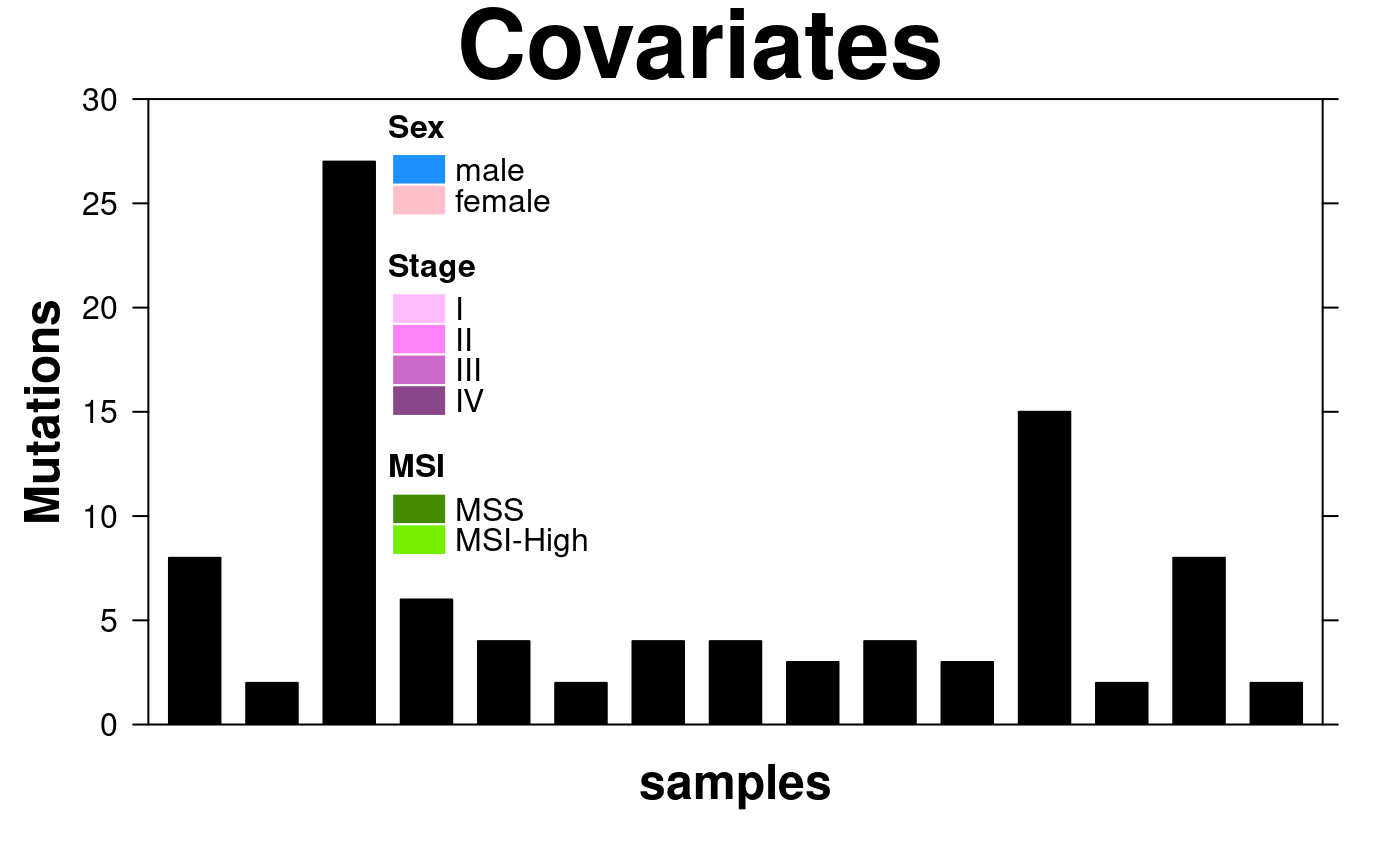 # Horizontal orientation
create.barplot(
# filename = tempfile(pattern = 'Barplot_Horizontal', fileext = '.tiff'),
# switch formula order
formula = samples ~ values,
data = barplot.data[barplot.data$mutation == 'nonsynonymous',],
main = 'Plot horizontally',
# Adjusting the panel layout
plot.horizontal = TRUE,
# covariates
legend = list(
inside = list(fun = covariate.legend.grob)
),
inside.legend.auto = TRUE,
description = 'Barplot created by BoutrosLab.plotting.general',
resolution = 200
);
# Horizontal orientation
create.barplot(
# filename = tempfile(pattern = 'Barplot_Horizontal', fileext = '.tiff'),
# switch formula order
formula = samples ~ values,
data = barplot.data[barplot.data$mutation == 'nonsynonymous',],
main = 'Plot horizontally',
# Adjusting the panel layout
plot.horizontal = TRUE,
# covariates
legend = list(
inside = list(fun = covariate.legend.grob)
),
inside.legend.auto = TRUE,
description = 'Barplot created by BoutrosLab.plotting.general',
resolution = 200
);
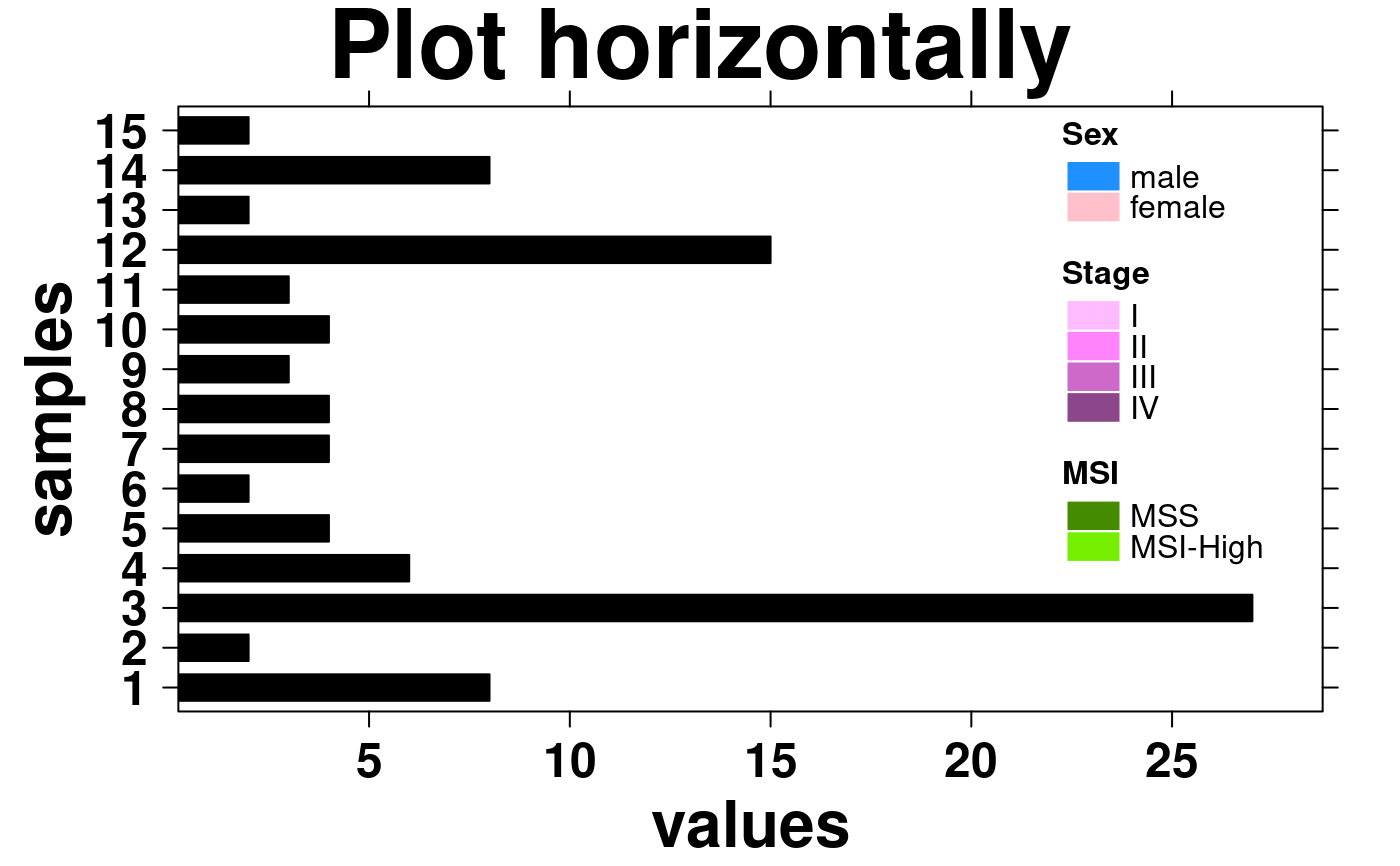 # Change bar thickness and add text labels
create.barplot(
# filename = tempfile(pattern = 'Barplot_Text_Labels', fileext = '.tiff'),
# switch formula order
formula = samples ~ values,
data = barplot.data[barplot.data$mutation == 'nonsynonymous',],
main = 'Text labels and thin bars',
# Adjusting the panel layout
plot.horizontal = TRUE,
box.ratio = 0.6,
add.text = TRUE,
text.x = 27.75,
text.y = 1:15,
text.labels = barplot.data[barplot.data$mutation == 'nonsynonymous','values'],
text.cex = 0.8,
text.fontface = 'italic',
description = 'Barplot created by BoutrosLab.plotting.general',
resolution = 200
);
# Change bar thickness and add text labels
create.barplot(
# filename = tempfile(pattern = 'Barplot_Text_Labels', fileext = '.tiff'),
# switch formula order
formula = samples ~ values,
data = barplot.data[barplot.data$mutation == 'nonsynonymous',],
main = 'Text labels and thin bars',
# Adjusting the panel layout
plot.horizontal = TRUE,
box.ratio = 0.6,
add.text = TRUE,
text.x = 27.75,
text.y = 1:15,
text.labels = barplot.data[barplot.data$mutation == 'nonsynonymous','values'],
text.cex = 0.8,
text.fontface = 'italic',
description = 'Barplot created by BoutrosLab.plotting.general',
resolution = 200
);
 # Error bars
error.data <- data.frame(
genes = rownames(microarray)[1:15],
values = apply(microarray[1:15,1:58], 1, mean),
error = apply(microarray[1:15,1:58], 1, sd)
);
create.barplot(
# filename = tempfile(pattern = 'Barplot_Error_Bars', fileext = '.tiff'),
# needs sequential x-axis
formula = values ~ 1:15,
data = error.data,
y.error.up = error.data$error,
xaxis.lab = error.data$genes,
main = 'Error bars',
xlab.lab = 'Gene',
ylab.lab = 'Change in Expression',
ylimits = c(0,14),
yat = seq(0,14,2),
xaxis.cex = 1,
yaxis.cex = 1,
xaxis.rot = 45,
xlab.cex = 1.5,
ylab.cex = 1.5,
xaxis.fontface = 1,
yaxis.fontface = 1,
description = 'Barplot created by BoutrosLab.plotting.general',
resolution = 100
);
# Error bars
error.data <- data.frame(
genes = rownames(microarray)[1:15],
values = apply(microarray[1:15,1:58], 1, mean),
error = apply(microarray[1:15,1:58], 1, sd)
);
create.barplot(
# filename = tempfile(pattern = 'Barplot_Error_Bars', fileext = '.tiff'),
# needs sequential x-axis
formula = values ~ 1:15,
data = error.data,
y.error.up = error.data$error,
xaxis.lab = error.data$genes,
main = 'Error bars',
xlab.lab = 'Gene',
ylab.lab = 'Change in Expression',
ylimits = c(0,14),
yat = seq(0,14,2),
xaxis.cex = 1,
yaxis.cex = 1,
xaxis.rot = 45,
xlab.cex = 1.5,
ylab.cex = 1.5,
xaxis.fontface = 1,
yaxis.fontface = 1,
description = 'Barplot created by BoutrosLab.plotting.general',
resolution = 100
);
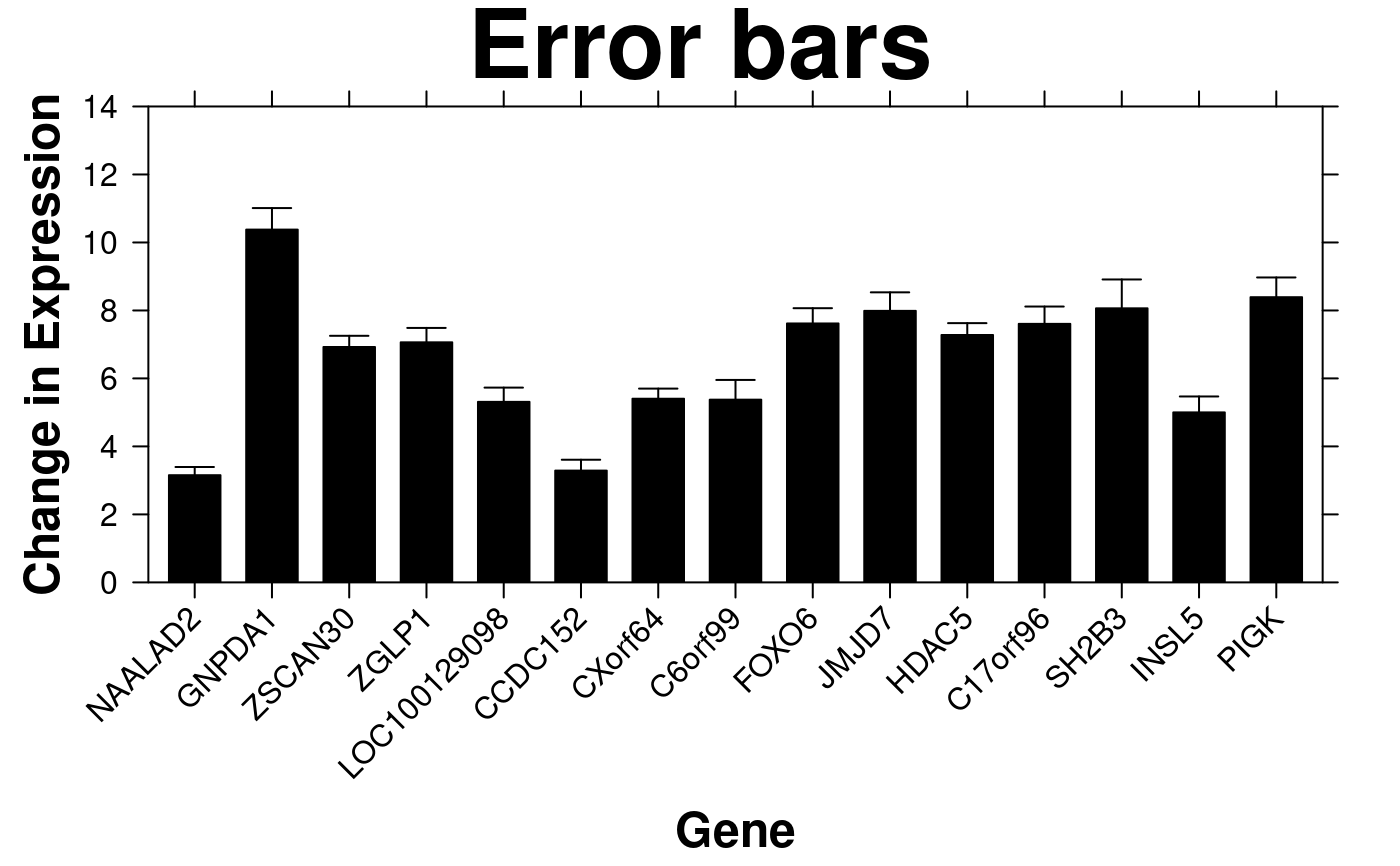 create.barplot(
# filename = tempfile(pattern = 'Barplot_Error_Bars_Horizontal', fileext = '.tiff'),
# needs sequential x-axis
formula = values ~ 1:15,
data = error.data,
y.error.up = error.data$error,
yaxis.lab = error.data$genes,
plot.horizontal = TRUE,
main = 'Error bars',
xlab.lab = 'Gene',
ylab.lab = 'Change in Expression',
xaxis.cex = 1,
yaxis.cex = 1,
xaxis.rot = 45,
xlab.cex = 1.5,
ylab.cex = 1.5,
xaxis.fontface = 1,
yaxis.fontface = 1,
description = 'Barplot created by BoutrosLab.plotting.general',
resolution = 100
);
create.barplot(
# filename = tempfile(pattern = 'Barplot_Error_Bars_Horizontal', fileext = '.tiff'),
# needs sequential x-axis
formula = values ~ 1:15,
data = error.data,
y.error.up = error.data$error,
yaxis.lab = error.data$genes,
plot.horizontal = TRUE,
main = 'Error bars',
xlab.lab = 'Gene',
ylab.lab = 'Change in Expression',
xaxis.cex = 1,
yaxis.cex = 1,
xaxis.rot = 45,
xlab.cex = 1.5,
ylab.cex = 1.5,
xaxis.fontface = 1,
yaxis.fontface = 1,
description = 'Barplot created by BoutrosLab.plotting.general',
resolution = 100
);
 # Grid lines
create.barplot(
# filename = tempfile(pattern = 'Barplot_Gridlines', fileext = '.tiff'),
formula = values ~ samples,
data = barplot.data[barplot.data$mutation == 'nonsynonymous',],
main = 'Gridlines',
xlab.lab = 'Samples',
ylab.lab = 'Nonsynonymous SNVs',
ylimits = c(0,30),
yat = seq(0,30,5),
xaxis.cex = 1,
yaxis.cex = 1,
xlab.cex = 1.5,
ylab.cex = 1.5,
xaxis.fontface = 1,
yaxis.fontface = 1,
# Grid lines
add.grid = TRUE,
xgrid.at = seq(0,15,2),
col = sex.colours,
legend = list(
inside = list(
fun = draw.key,
args = list(
key = list(
points = list(
col = 'black',
pch = 22,
cex = 3,
fill = c('dodgerblue', 'pink')
),
text = list(
lab = c('Male','Female')
),
padding.text = 5,
cex = 1
)
),
# Positioning legend on plot
x = 0.75,
y = 0.95
)
),
description = 'Barplot created by BoutrosLab.plotting.general',
resolution = 200
);
# Grid lines
create.barplot(
# filename = tempfile(pattern = 'Barplot_Gridlines', fileext = '.tiff'),
formula = values ~ samples,
data = barplot.data[barplot.data$mutation == 'nonsynonymous',],
main = 'Gridlines',
xlab.lab = 'Samples',
ylab.lab = 'Nonsynonymous SNVs',
ylimits = c(0,30),
yat = seq(0,30,5),
xaxis.cex = 1,
yaxis.cex = 1,
xlab.cex = 1.5,
ylab.cex = 1.5,
xaxis.fontface = 1,
yaxis.fontface = 1,
# Grid lines
add.grid = TRUE,
xgrid.at = seq(0,15,2),
col = sex.colours,
legend = list(
inside = list(
fun = draw.key,
args = list(
key = list(
points = list(
col = 'black',
pch = 22,
cex = 3,
fill = c('dodgerblue', 'pink')
),
text = list(
lab = c('Male','Female')
),
padding.text = 5,
cex = 1
)
),
# Positioning legend on plot
x = 0.75,
y = 0.95
)
),
description = 'Barplot created by BoutrosLab.plotting.general',
resolution = 200
);
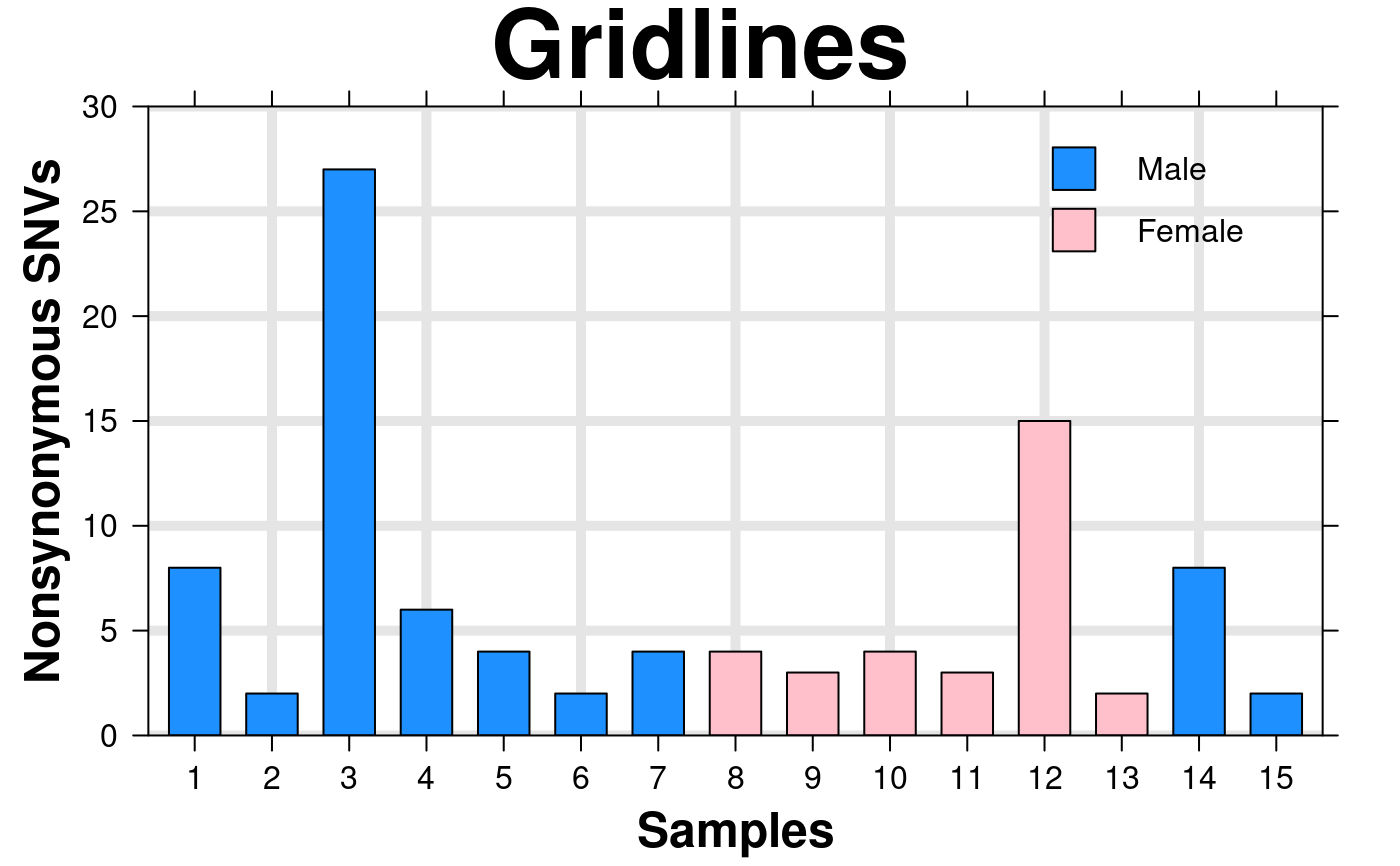 # Grid lines 2
create.barplot(
# filename = tempfile(pattern = 'Barplot_Gridlines_GreyBG', fileext = '.tiff'),
formula = values ~ samples,
data = barplot.data[barplot.data$mutation == 'nonsynonymous',],
main = 'Gridlines & grey background',
xlab.lab = 'Samples',
ylab.lab = 'Nonsynonymous SNVs',
ylimits = c(0,30),
yat = seq(0,30,5),
xaxis.cex = 1,
yaxis.cex = 1,
xlab.cex = 1.5,
ylab.cex = 1.5,
xaxis.fontface = 1,
yaxis.fontface = 1,
# Grid lines
background.col = 'grey85',
add.grid = TRUE,
xgrid.at = seq(0,15,2),
col = sex.colours,
legend = list(
inside = list(
fun = draw.key,
args = list(
key = list(
points = list(
col = 'black',
pch = 22,
cex = 3,
fill = c('dodgerblue', 'pink')
),
text = list(
lab = c('Male','Female')
),
padding.text = 5,
cex = 1
)
),
# Positioning legend on plot
x = 0.75,
y = 0.95
)
),
description = 'Barplot created by BoutrosLab.plotting.general',
resolution = 200
);
# Grid lines 2
create.barplot(
# filename = tempfile(pattern = 'Barplot_Gridlines_GreyBG', fileext = '.tiff'),
formula = values ~ samples,
data = barplot.data[barplot.data$mutation == 'nonsynonymous',],
main = 'Gridlines & grey background',
xlab.lab = 'Samples',
ylab.lab = 'Nonsynonymous SNVs',
ylimits = c(0,30),
yat = seq(0,30,5),
xaxis.cex = 1,
yaxis.cex = 1,
xlab.cex = 1.5,
ylab.cex = 1.5,
xaxis.fontface = 1,
yaxis.fontface = 1,
# Grid lines
background.col = 'grey85',
add.grid = TRUE,
xgrid.at = seq(0,15,2),
col = sex.colours,
legend = list(
inside = list(
fun = draw.key,
args = list(
key = list(
points = list(
col = 'black',
pch = 22,
cex = 3,
fill = c('dodgerblue', 'pink')
),
text = list(
lab = c('Male','Female')
),
padding.text = 5,
cex = 1
)
),
# Positioning legend on plot
x = 0.75,
y = 0.95
)
),
description = 'Barplot created by BoutrosLab.plotting.general',
resolution = 200
);
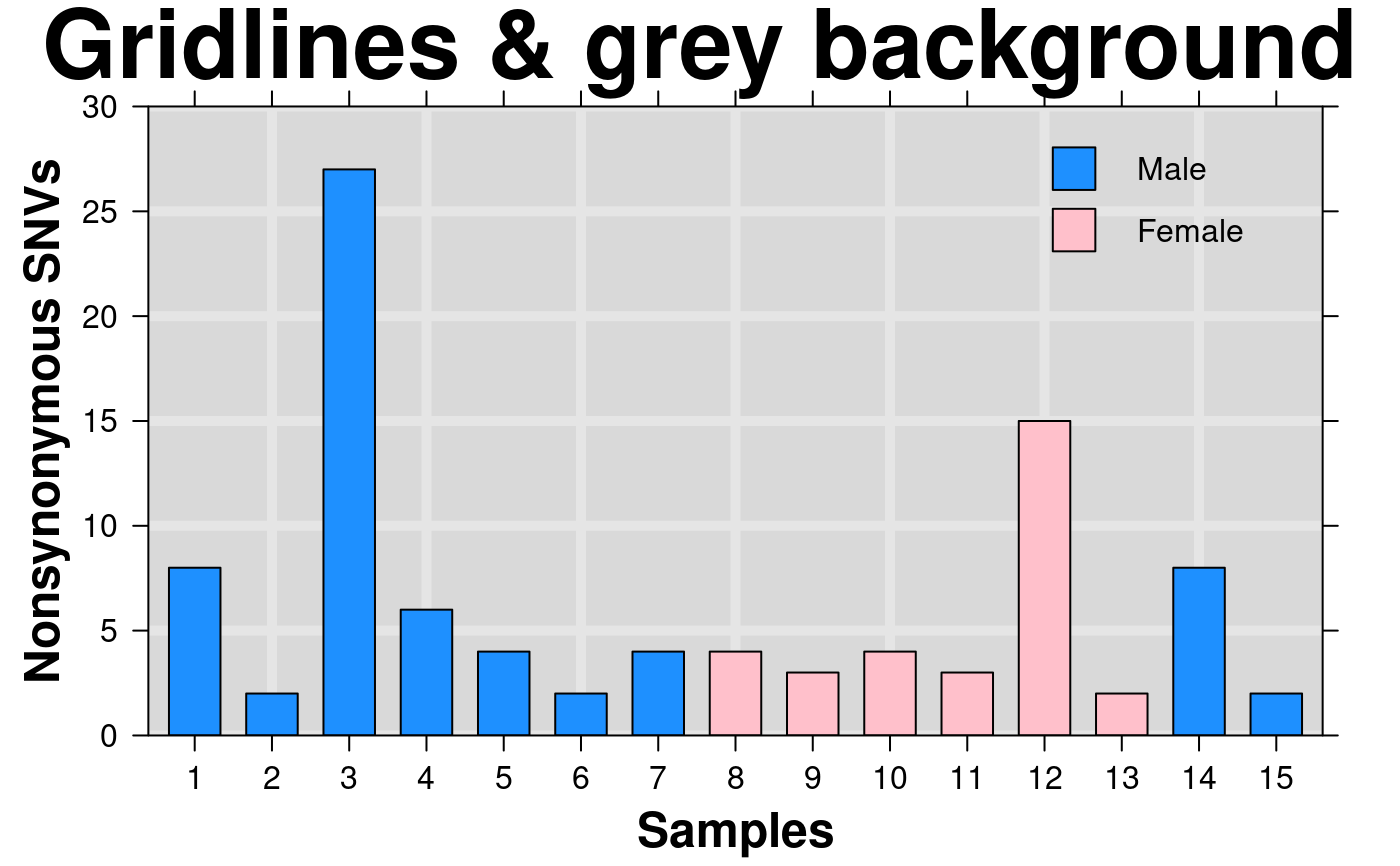 # Labels
create.barplot(
# filename = tempfile(pattern = 'Barplot_Labels', fileext = '.tiff'),
formula = values ~ samples,
data = barplot.data[barplot.data$mutation == 'nonsynonymous',],
main = 'Labels',
xlab.lab = 'Samples',
ylab.lab = 'Nonsynonymous SNVs',
ylimits = c(0,30),
yat = seq(0,30,5),
xaxis.cex = 1,
yaxis.cex = 1,
xlab.cex = 1.5,
ylab.cex = 1.5,
xaxis.fontface = 1,
yaxis.fontface = 1,
# Labels
text.above.bars = list(
labels = c('*','27','15','*'),
padding = 0.75,
bar.locations = c(1, 3, 12, 14),
rotation = 0
),
col = sex.colours,
legend = list(
inside = list(
fun = draw.key,
args = list(
key = list(
points = list(
col = 'black',
pch = 22,
cex = 3,
fill = c('dodgerblue', 'pink')
),
text = list(
lab = c('Male','Female')
),
padding.text = 5,
cex = 1
)
),
# Positioning legend on plot
x = 0.75,
y = 0.95
)
),
description = 'Barplot created by BoutrosLab.plotting.general',
resolution = 200
);
# Labels
create.barplot(
# filename = tempfile(pattern = 'Barplot_Labels', fileext = '.tiff'),
formula = values ~ samples,
data = barplot.data[barplot.data$mutation == 'nonsynonymous',],
main = 'Labels',
xlab.lab = 'Samples',
ylab.lab = 'Nonsynonymous SNVs',
ylimits = c(0,30),
yat = seq(0,30,5),
xaxis.cex = 1,
yaxis.cex = 1,
xlab.cex = 1.5,
ylab.cex = 1.5,
xaxis.fontface = 1,
yaxis.fontface = 1,
# Labels
text.above.bars = list(
labels = c('*','27','15','*'),
padding = 0.75,
bar.locations = c(1, 3, 12, 14),
rotation = 0
),
col = sex.colours,
legend = list(
inside = list(
fun = draw.key,
args = list(
key = list(
points = list(
col = 'black',
pch = 22,
cex = 3,
fill = c('dodgerblue', 'pink')
),
text = list(
lab = c('Male','Female')
),
padding.text = 5,
cex = 1
)
),
# Positioning legend on plot
x = 0.75,
y = 0.95
)
),
description = 'Barplot created by BoutrosLab.plotting.general',
resolution = 200
);
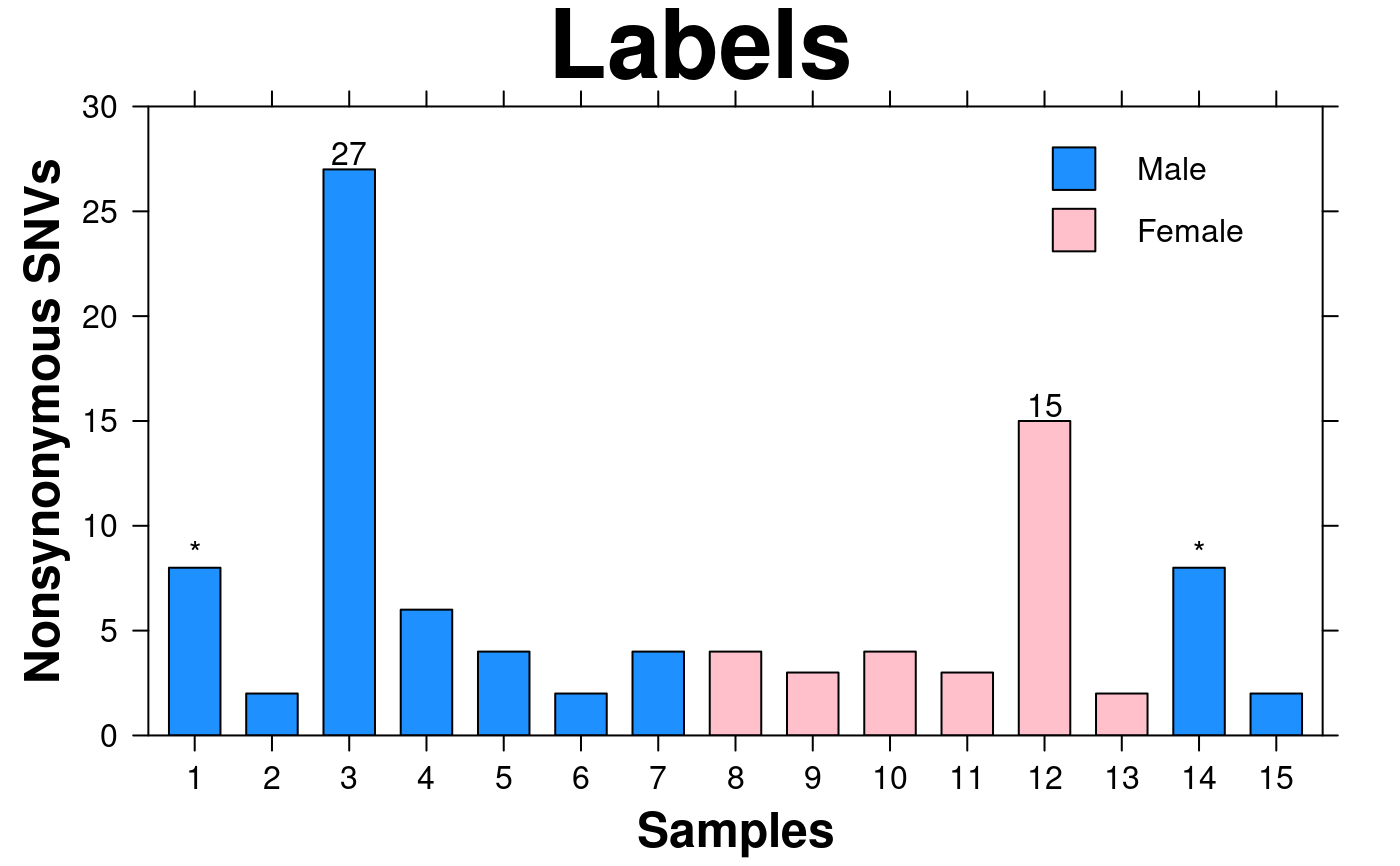 # lines
create.barplot(
# filename = tempfile(pattern = 'Barplot_Lines', fileext = '.tiff'),
formula = values ~ samples,
data = barplot.data[barplot.data$mutation == 'nonsynonymous',],
main = 'Lines',
xlab.lab = 'Samples',
ylab.lab = 'Nonsynonymous SNVs',
ylimits = c(0,30),
yat = seq(0,30,5),
xaxis.cex = 1,
yaxis.cex = 1,
xlab.cex = 1.5,
ylab.cex = 1.5,
xaxis.fontface = 1,
yaxis.fontface = 1,
# Lines
sample.order = 'increasing',
line.func = function(x) {0.1*x**2},
line.from = 0,
line.to = 16,
line.col = 'darkgrey',
abline.h = 10,
abline.col = 'red',
col = sex.colours,
legend = list(
inside = list(
fun = draw.key,
args = list(
key = list(
points = list(
col = 'black',
pch = 22,
cex = 3,
fill = c('dodgerblue', 'pink')
),
text = list(
lab = c('Male','Female')
),
padding.text = 5,
cex = 1
)
),
# Positioning legend on plot
x = 0.75,
y = 0.95
)
),
description = 'Barplot created by BoutrosLab.plotting.general',
resolution = 200
);
# lines
create.barplot(
# filename = tempfile(pattern = 'Barplot_Lines', fileext = '.tiff'),
formula = values ~ samples,
data = barplot.data[barplot.data$mutation == 'nonsynonymous',],
main = 'Lines',
xlab.lab = 'Samples',
ylab.lab = 'Nonsynonymous SNVs',
ylimits = c(0,30),
yat = seq(0,30,5),
xaxis.cex = 1,
yaxis.cex = 1,
xlab.cex = 1.5,
ylab.cex = 1.5,
xaxis.fontface = 1,
yaxis.fontface = 1,
# Lines
sample.order = 'increasing',
line.func = function(x) {0.1*x**2},
line.from = 0,
line.to = 16,
line.col = 'darkgrey',
abline.h = 10,
abline.col = 'red',
col = sex.colours,
legend = list(
inside = list(
fun = draw.key,
args = list(
key = list(
points = list(
col = 'black',
pch = 22,
cex = 3,
fill = c('dodgerblue', 'pink')
),
text = list(
lab = c('Male','Female')
),
padding.text = 5,
cex = 1
)
),
# Positioning legend on plot
x = 0.75,
y = 0.95
)
),
description = 'Barplot created by BoutrosLab.plotting.general',
resolution = 200
);
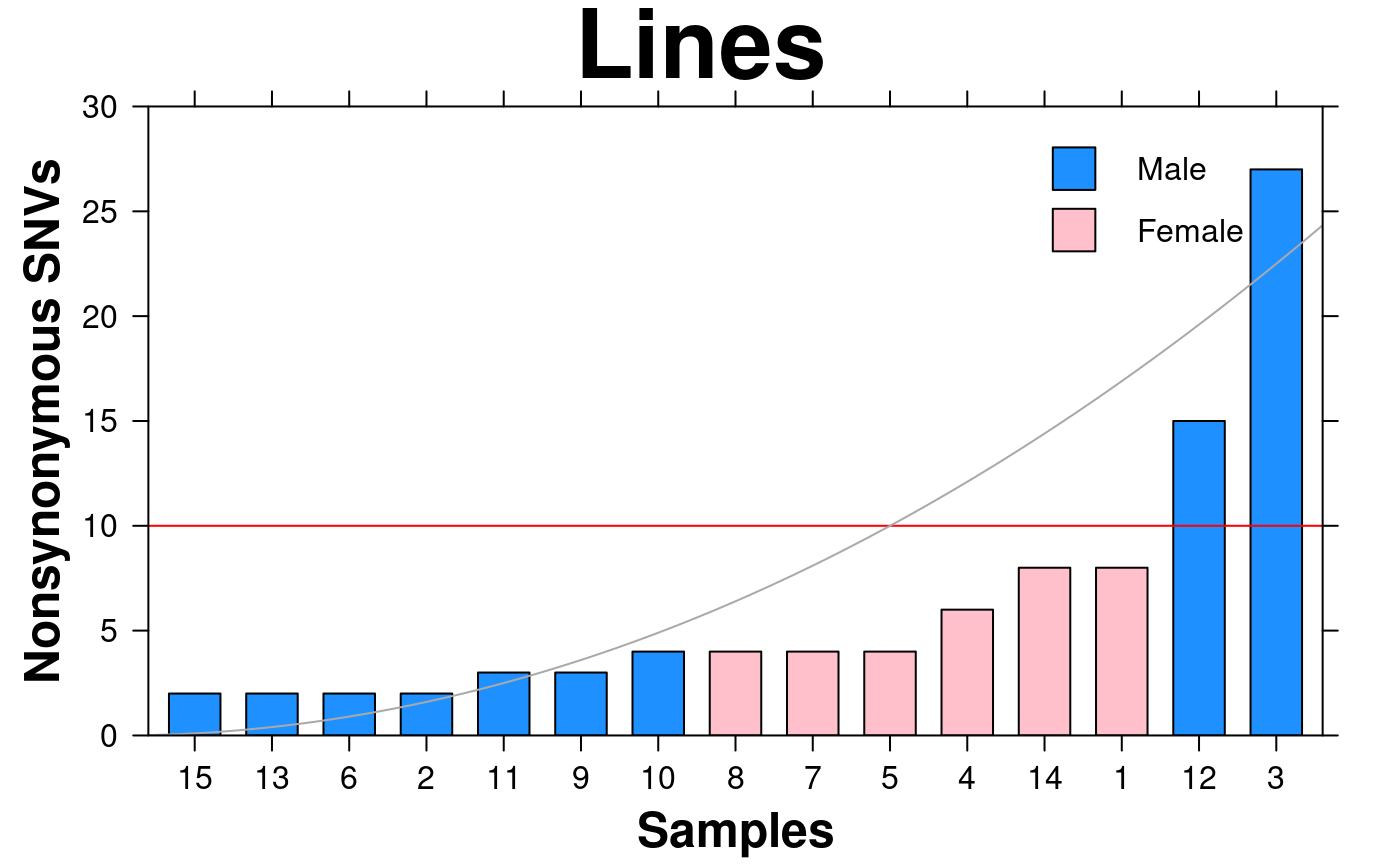 # Background rectangle
create.barplot(
# filename = tempfile(pattern = 'Barplot_Bg_Rectangle', fileext = '.tiff'),
formula = values ~ samples,
data = barplot.data[barplot.data$mutation == 'nonsynonymous',],
main = 'Background rectangle',
xlab.lab = 'Samples',
ylab.lab = 'Nonsynonymous SNVs',
ylimits = c(0,30),
yat = seq(0,30,5),
xaxis.cex = 1,
yaxis.cex = 1,
xlab.cex = 1.5,
ylab.cex = 1.5,
xaxis.fontface = 1,
yaxis.fontface = 1,
sample.order = 'increasing',
# Background rectangle
add.rectangle = TRUE,
xleft.rectangle = seq(0.5, 14.5, 2),
ybottom.rectangle = 0,
xright.rectangle = seq(1.5, 15.5, 2),
ytop.rectangle = 30,
col.rectangle = 'lightgrey',
col = sex.colours,
legend = list(
inside = list(
fun = draw.key,
args = list(
key = list(
points = list(
col = 'black',
pch = 22,
cex = 3,
fill = c('dodgerblue', 'pink')
),
text = list(
lab = c('Male','Female')
),
padding.text = 5,
cex = 1
)
),
# Positioning legend on plot
x = 0.75,
y = 0.95
)
),
description = 'Barplot created by BoutrosLab.plotting.general',
resolution = 200
);
# Background rectangle
create.barplot(
# filename = tempfile(pattern = 'Barplot_Bg_Rectangle', fileext = '.tiff'),
formula = values ~ samples,
data = barplot.data[barplot.data$mutation == 'nonsynonymous',],
main = 'Background rectangle',
xlab.lab = 'Samples',
ylab.lab = 'Nonsynonymous SNVs',
ylimits = c(0,30),
yat = seq(0,30,5),
xaxis.cex = 1,
yaxis.cex = 1,
xlab.cex = 1.5,
ylab.cex = 1.5,
xaxis.fontface = 1,
yaxis.fontface = 1,
sample.order = 'increasing',
# Background rectangle
add.rectangle = TRUE,
xleft.rectangle = seq(0.5, 14.5, 2),
ybottom.rectangle = 0,
xright.rectangle = seq(1.5, 15.5, 2),
ytop.rectangle = 30,
col.rectangle = 'lightgrey',
col = sex.colours,
legend = list(
inside = list(
fun = draw.key,
args = list(
key = list(
points = list(
col = 'black',
pch = 22,
cex = 3,
fill = c('dodgerblue', 'pink')
),
text = list(
lab = c('Male','Female')
),
padding.text = 5,
cex = 1
)
),
# Positioning legend on plot
x = 0.75,
y = 0.95
)
),
description = 'Barplot created by BoutrosLab.plotting.general',
resolution = 200
);
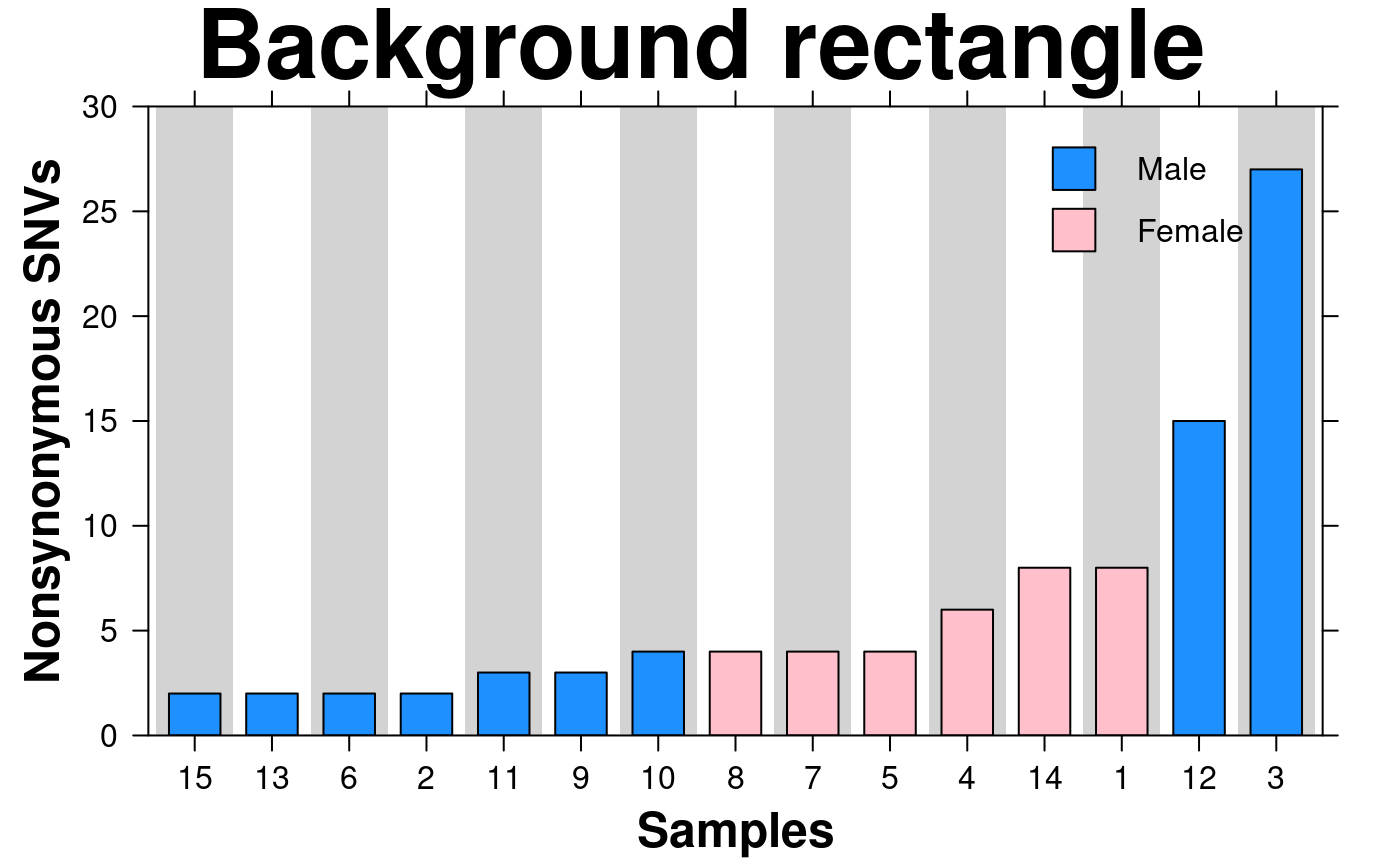 # Raster
create.barplot(
# filename = tempfile(pattern = 'Barplot_with_raster', fileext = '.tiff'),
formula = values ~ samples,
data = barplot.data[barplot.data$mutation == 'nonsynonymous',],
main = 'Raster fill',
xlab.lab = 'Samples',
ylab.lab = 'Nonsynonymous SNVs',
ylimits = c(0,30),
yat = seq(0,30,5),
xaxis.cex = 1,
yaxis.cex = 1,
xlab.cex = 1.5,
ylab.cex = 1.5,
xaxis.fontface = 1,
yaxis.fontface = 1,
# filling bars with raster
raster = 1:10/10,
raster.just = 'bottom',
description = 'Description of image here',
resolution = 200
);
# Raster
create.barplot(
# filename = tempfile(pattern = 'Barplot_with_raster', fileext = '.tiff'),
formula = values ~ samples,
data = barplot.data[barplot.data$mutation == 'nonsynonymous',],
main = 'Raster fill',
xlab.lab = 'Samples',
ylab.lab = 'Nonsynonymous SNVs',
ylimits = c(0,30),
yat = seq(0,30,5),
xaxis.cex = 1,
yaxis.cex = 1,
xlab.cex = 1.5,
ylab.cex = 1.5,
xaxis.fontface = 1,
yaxis.fontface = 1,
# filling bars with raster
raster = 1:10/10,
raster.just = 'bottom',
description = 'Description of image here',
resolution = 200
);
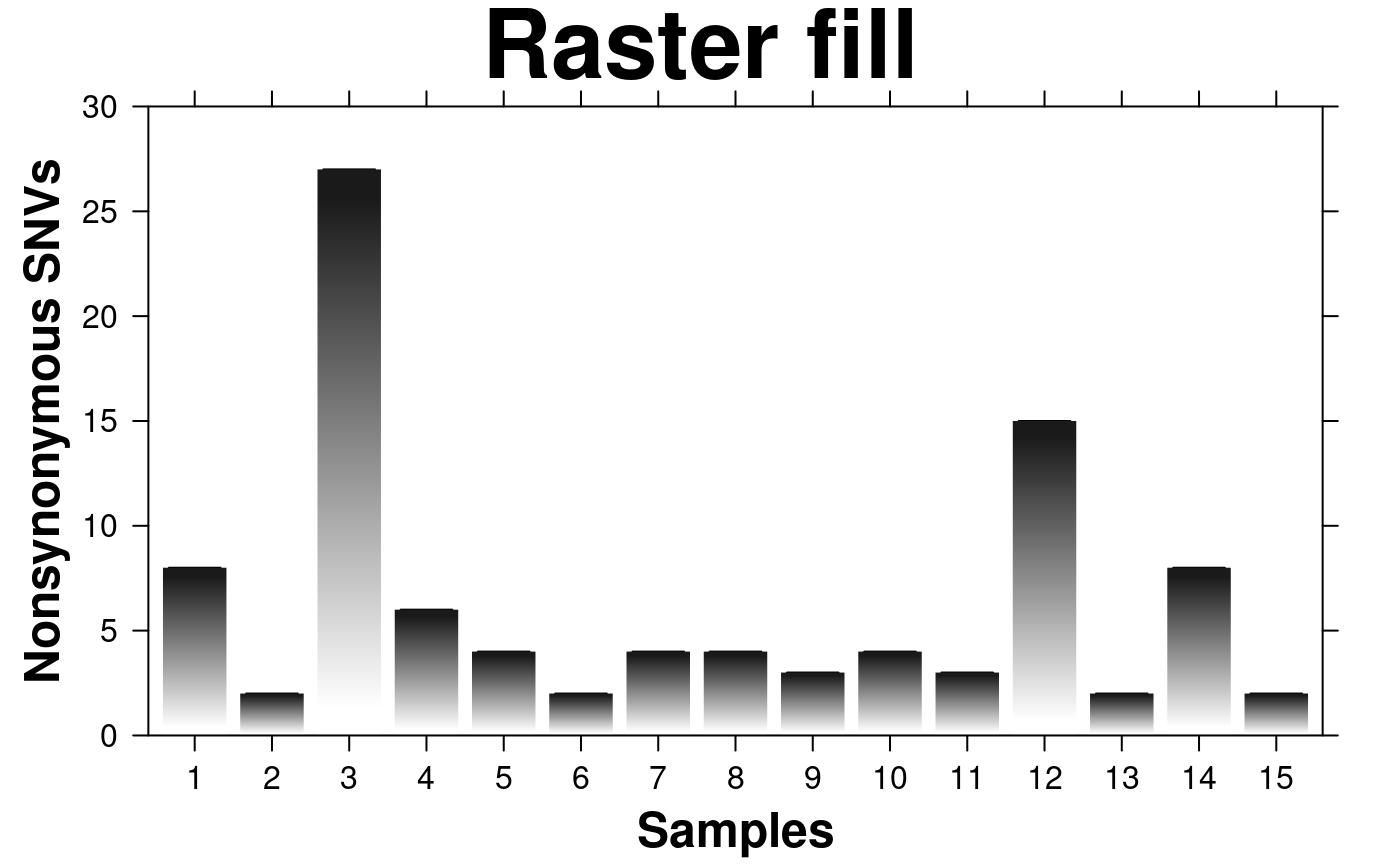 # Nature format
create.barplot(
# filename = tempfile(pattern = 'Barplot_Nature_style', fileext = '.tiff'),
formula = x ~ y,
data = simple.data,
yat = seq(0,16,2),
main = 'Nature style',
# set style to Nature
style = 'Nature',
# demonstrating how to italicize character variables
ylab.lab = expression(paste('italicized ', italic('a'))),
# demonstrating how to create en-dashes
xlab.lab = expression(paste('en dashs: 1','\u2013', '10'^'\u2013', ''^3)),
resolution = 200
);
#> Warning: Setting resolution to 1200 dpi.
#> Warning: Nature also requires italicized single-letter variables and
#> en-dashes for ranges and negatives. See example in documentation for how to do this.
#> Warning: Avoid red-green colour schemes, create TIFF files, do not outline the figure or legend.
# Nature format
create.barplot(
# filename = tempfile(pattern = 'Barplot_Nature_style', fileext = '.tiff'),
formula = x ~ y,
data = simple.data,
yat = seq(0,16,2),
main = 'Nature style',
# set style to Nature
style = 'Nature',
# demonstrating how to italicize character variables
ylab.lab = expression(paste('italicized ', italic('a'))),
# demonstrating how to create en-dashes
xlab.lab = expression(paste('en dashs: 1','\u2013', '10'^'\u2013', ''^3)),
resolution = 200
);
#> Warning: Setting resolution to 1200 dpi.
#> Warning: Nature also requires italicized single-letter variables and
#> en-dashes for ranges and negatives. See example in documentation for how to do this.
#> Warning: Avoid red-green colour schemes, create TIFF files, do not outline the figure or legend.
 # Left Justified Example
create.barplot(
# filename = tempfile(pattern = 'Barplot_TwoTopLabelsLeftJustified', fileext = '.tiff'),
formula = x ~ y,
data = simple.data,
yat = seq(0,16,2),
ylab.label = NULL,
# set top label details
xlab.top.label = 'Sample Label',
xlab.top.cex = 1.5,
xlab.top.x = -0.125,
xlab.top.y = 0.5,
xlab.top.just = 'left',
# set main label details
main = 'Sample Main',
main.just = 'left',
main.x = 0,
main.y = 0.6,
top.padding = 1,
resolution = 200
);
# Left Justified Example
create.barplot(
# filename = tempfile(pattern = 'Barplot_TwoTopLabelsLeftJustified', fileext = '.tiff'),
formula = x ~ y,
data = simple.data,
yat = seq(0,16,2),
ylab.label = NULL,
# set top label details
xlab.top.label = 'Sample Label',
xlab.top.cex = 1.5,
xlab.top.x = -0.125,
xlab.top.y = 0.5,
xlab.top.just = 'left',
# set main label details
main = 'Sample Main',
main.just = 'left',
main.x = 0,
main.y = 0.6,
top.padding = 1,
resolution = 200
);
 # }
# }